Vol. 70, No. 13 (2021)
2021-07-05
SPECIAL TOPIC—Toward making functional devices at an atomic scale: Fundamentals and frontiers

EDITOR'S SUGGESTION
2021, 70 (13): 133101.
doi: 10.7498/aps.70.20210708
Abstract +
Two-dimensional ice is a new type of atomic-scale material obtained by typical atomic manufacturing techniques. Its structure and nucleation growth play an essential role in many fields such as material science, tribology, biology, atmospheric science and planetary science. Although the structural properties of two-dimensional ice have been investigated extensively, little is known about its electronic and optical properties. In this paper, the main electronic, optical, dielectric properties and infrared spectra of two-dimensional ice I at zero temperature are calculated by density functional theory and linear response theory. The study reveals that the two-dimensional ice I is an indirect band gap and its optical properties show anisotropic lattice. And the absorption energy range for the two-dimensional ice I is in the ultraviolet region of the spectrum (> 3.2 eV) and the visible region of the spectrum (between 2 and 3.2 eV), respectively. Secondly, the radial distribution function and the vibrational density of states of the two-dimensional ice I at a finite temperature are simulated by ab initio molecular dynamics method. For the structure of the two-dimensional ice I, whether SCAN or PBE functional, after considering the vdW effect, there is almost no effect on the atomic distance, while by comparison, the SCAN functional and the PBE functional are quite different. Therefore, it can be seen that the main reason for affecting the distance between atoms in the structure is due to the consideration of the strong confinement effect of SCAN. In terms of the vibration characteristics of two-dimensional ice I, comparing with PBE and vdW-DF-ob86, the first two peaks of the IR spectrum of SCAN + rVV10 functional show blue shift, and the two peaks in the high frequency region present the red shift. Therefore, considering the strong confinement effect of SCAN, the intermolecular tensile vibration of two-dimensional ice I becomes stronger, while the intramolecular H—O—H bending vibration and O—H bond tensile vibration become weaker. The effect of van der Waals action on vibration properties is not obvious. Furthermore, we investigate the temperature effects on the vibration spectra of two-dimensional ice I. It is found that with the increase of temperature, the intermolecular librational mode weakens at a low frequency, the intramolecular bending and stretching bands gradually broaden, and the intramolecular O-H stretching peak presents the blue-shifts with temperature rising. The results of this paper reveal the electronic structure of atomic-scale two-dimensional ice I, and demonstrate its unique optical absorption mechanism, which is helpful in further experimentally characterizing and manipulating the two-dimensional ice on an atomic scale. Since the two-dimensional ice on the surface can promote or inhibit the formation of three-dimensional ice, it has potential applications in designing and developing the anti-icing materials. In addition, two-dimensional ice itself can also be used as a unique two-dimensional material, providing a brand-new standard material for high-temperature superconductivity, deep-ultraviolet detection, cryo-electron microscopy imaging.

EDITOR'S SUGGESTION
2021, 70 (13): 134207.
doi: 10.7498/aps.70.20210731
Abstract +
In this paper, the high-order harmonic generation by the interaction between strong laser and bilayer MoS2 material is studied by numerically solving the multi-band semiconductor Bloch equations. It is found that the conversion efficiency of high-order harmonics generated by T-stacking bilayer MoS2 is one order of magnitude higher than that of AA-stacking bilayer MoS2. The theoretical analysis shows that due to the breaking of crystal symmetry under the atomic level dislocation, part of the interband forbidden transition paths are opened, and the excitation channels of interband transition are increased, which greatly increases the carrier transition probability and enhances the high-order harmonic conversion efficiency. In addition, the study of wavelength scaling of harmonic yield shows that the enhanced high-order harmonics in T-stacking bilayer are better wavelength-dependent under the action of a long wavelength laser (> 2000 nm). This work provides a new idea of how to optimize and enhance the conversion efficiency of solid-state high-order harmonics.
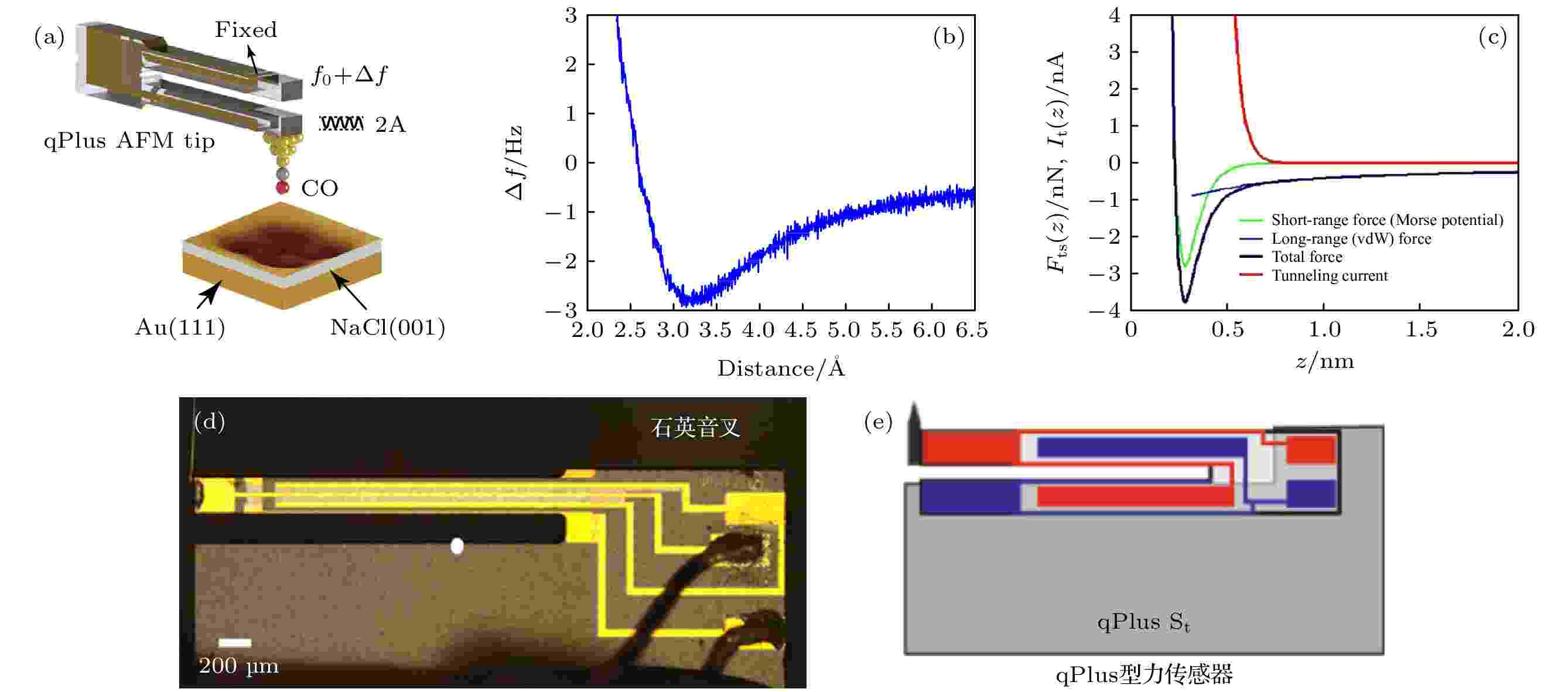
EDITOR'S SUGGESTION
2021, 70 (13): 136802.
doi: 10.7498/aps.70.20202129
Abstract +
In this review paper, we introduce representative research work on single atomic/molecular manipulations by atomic force microscopy (AFM), which possesses extraordinary ability to resolve atomic and chemical bonds, and charge density distributions of samples. We first introduce the working principle of AFM, then focus on recent advances in atom manipulation at room temperature, force characterization in the process of atom/molecule manipulation, and charge manipulation on insulating substrates. This review covers the following four aspects: 1) the imaging principle of AFM and the atomic characterization of typical molecules such as pentacene and C60; 2) the mechanical manipulation and atomic recognition capability of AFM at room temperature; 3) the characterization of forces in the process of surface isomerization and adsorption configuration changes of the molecules; 4) the manipulation of charge states and the characterization of single and multiple molecules on insulating substrates. The capability of manipulation by AFM in these fields widens the range in atomic/molecular manipulation, which can provide new and well-established schemes for the analysis and precise control of the manipulation process, and can further contribute to the construction of nanoscale devices, such as “molecular switches” and storage components.
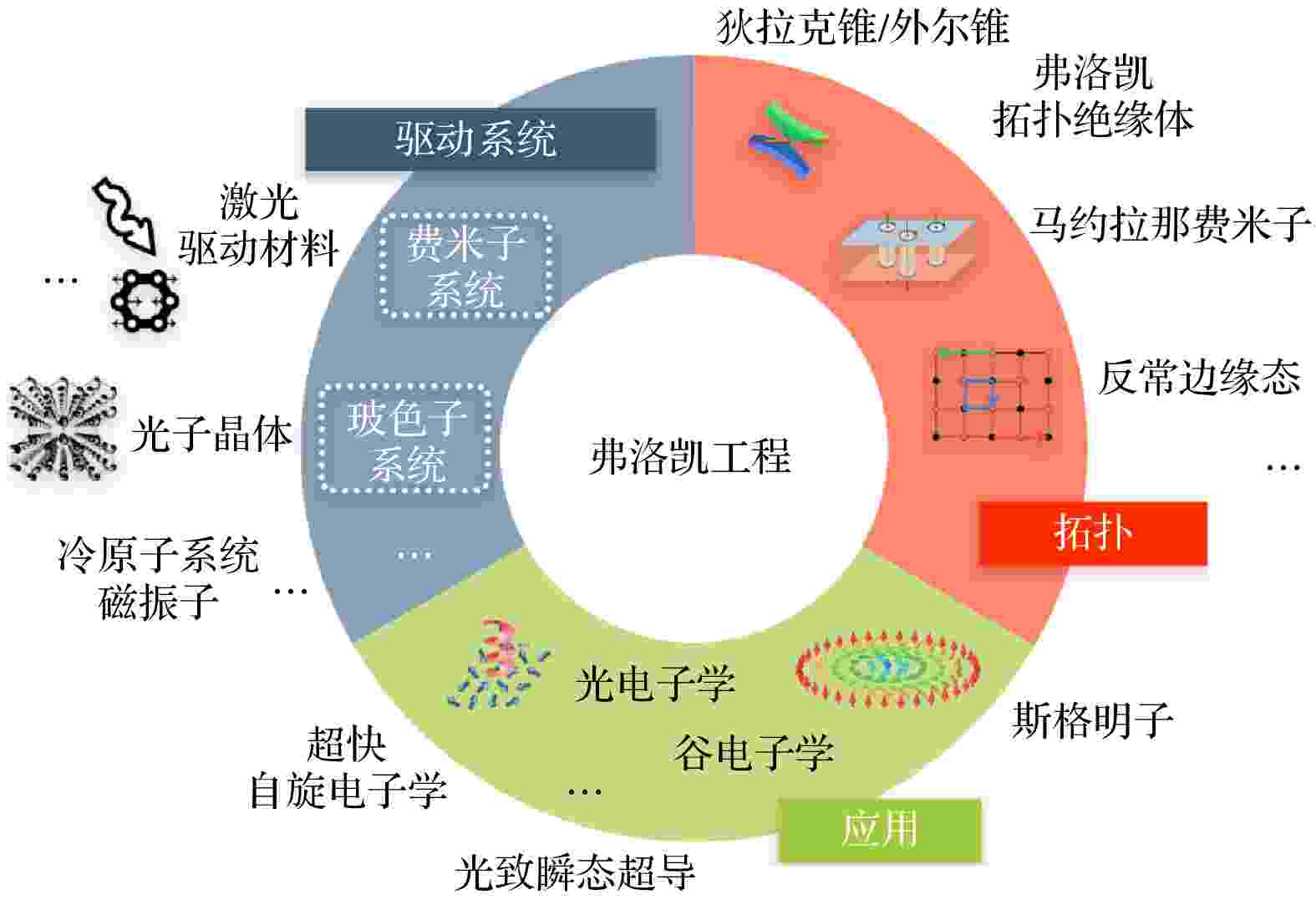
EDITOR'S SUGGESTION
2021, 70 (13): 138101.
doi: 10.7498/aps.70.20201808
Abstract +
The topology of quantum materials is the frontier research in condensed matter physics. In contrast with the conventional classification of materials by using the local symmetry breaking criterion, the states of quantum systems are classified according to the topology of wave functions. The potential applications of topological states may lead the traditional microelectronics to break through and accelerate the significant improvement in topological electronics. Most of the recent studies focus on the topological states of quantum systems under equilibrium conditions without external perturbations. The topological states of quantum systems far from the equilibrium under time-periodic driving have attracted wide attention. Here we first introduce the framework of Floquet engineering under the frame of the Floquet theorem. The nonequilibrium topological states of massless and massive Dirac fermions are discussed including the mechanism of phase transition. Light field driven electronic transition term in the quantum material gains extra time-dependent phase. Thereby the manipulation of effective transition term of the electron is realized to regulate the non-equilibrium topological states. We also mention how the photoinduced coherent phonon affects the nonequilibrium topological states of quantum systems from the perspective of atom manufacturing. Furthermore, research outlook on the nonequilibrium topological states is given. This review provides some clues to the design of physical properties and transport behaviors of quantum materials out of equilibrium.
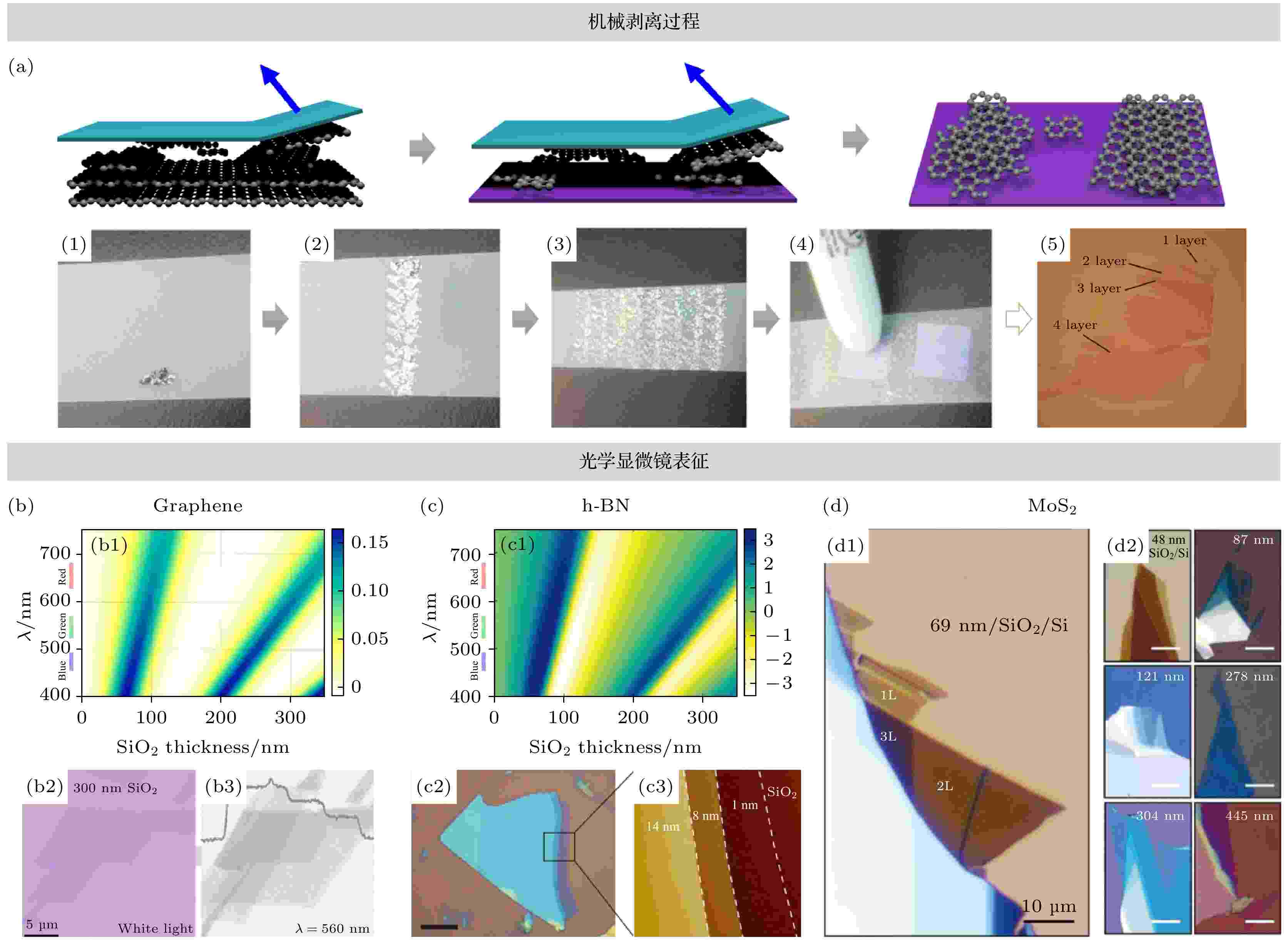
EDITOR'S SUGGESTION
2021, 70 (13): 138202.
doi: 10.7498/aps.70.20210929
Abstract +
Two-dimensional atomic crystals (2DACs) are the layered materials that can be exfoliated into the thickness of one unit cell, and attract extensive attention in current condensed matter physics. The atoms contained in a 2DAC are completely exposed, thus rendering them extremely sensitive to the external environment. Therefore, the exfoliation, transfer, rotation, stacking, encapsulation and device fabrication processes are particularly important for the electronic device quality and electrical transport properties of 2DACs. We review the recent progress of the transfer methods for 2DACs, especially the milestones in the improving of the transport properties of these two-dimensional electron gases (2DEGs). For electronic devices based on 2DACs, the quality of the devices is evaluated in terms of the disorder of 2DEG, contact resistance, carrier mobility, and observed quantum Hall states, and their corresponding transfer technology, device structure and fabrication processes are also discussed in detail.

EDITOR'S SUGGESTION
2021, 70 (13): 138501.
doi: 10.7498/aps.70.20210498
Abstract +
The spin and valley degree of freedom are a novel way to extend the functionalities of spintronic and valleytronic devices. A traditional, room-temperature way of examining the spin polarization generates the photocurrent whose magnitude and polarity depend on chirality of induced optical excitation. The circularly polarized photovoltaic effect is a kind of second-order nonlinear photoelectric response, which means that the photocurrent generated varies with the polarization angle of circularly polarized light. The generation of photocurrent depends on many factors such as spin, valley polarization, symmetry and Berry curvature, so it can reveal the fundamental physical properties of materials. In this review, we discuss the main mechanisms of circularly polarized photovoltaic effect in different material systems, including circularly polarized optical current caused by symmetry breakdown of Rashba spin-orbit coupling in semiconductor heterojunction, the electron momentum selection caused by Berry curvature and Pauli blocking in topological Weyl semimetals, and the valley polarization current generated by circularly polarized light in TMDC. Additionally, the recent progress of applications of circular photogalvanic effect is also presented.
YOUNG SCIENTISTS’ FORUM
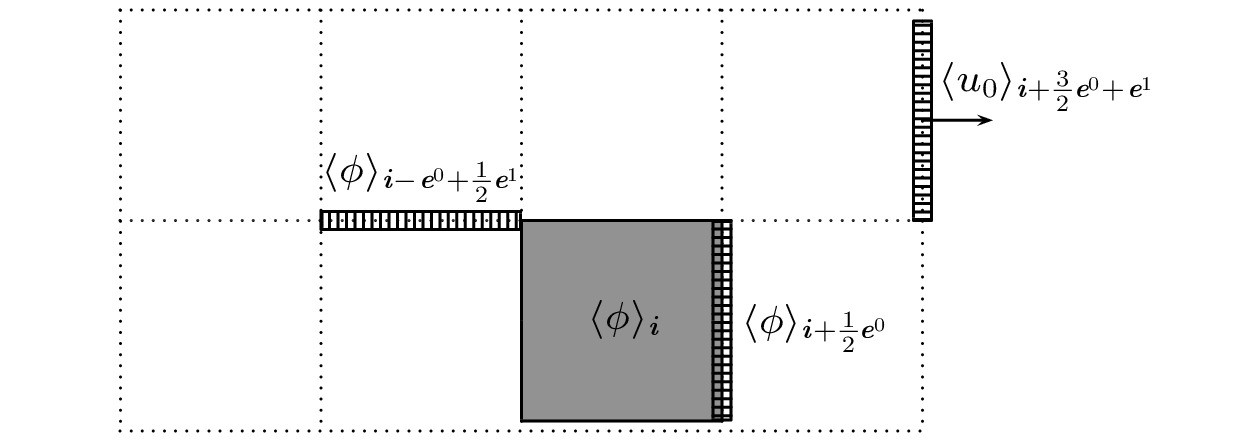
YOUNG SCIENTISTS' FORUM
2021, 70 (13): 130201.
doi: 10.7498/aps.70.20210259
Abstract +
The incompressible Navier-Stokes equations (INSE) are the basic governing equations of fluid dynamics, and their numerical solutions are of great significance. In this review paper, we first recollect some classical projection methods and their relatives in the past 50 years and then fully explain the recent fourth-order projection method called GePUP [Zhang Q 2016 J. Sci. Comput. 67 1134 ]. Based on a generic projection operator and the UPPE formulation of the INSE [Liu J G, Liu J, Pego R L 2007 Comm. Pure Appl. Math. 60 1443 ], we derive the GePUP equations, which retain the advantage of UPPE that the velocity divergence is governed by a heat equation and is thus well under control. In comparison with UPPE, the GePUP formulation is advantageous in three aspects: (1) its derivation depends on none of the properties of the Leray-Helmholtz projection; (2) the evolutionary velocity can be divergent, thus it is directly applicable to numerical calculations with nonzero velocity divergence; (3) the Leray-Helmholtz projection does appear on the right-hand sides of the governing equations, thus making it transparent to analyze the accuracy and stability issues raised by numerically approximating the Leray-Helmholtz projection. As the most appealing feature of GePUP, temporal integration and spatial discretization are completely decoupled and can be treated as black boxes, so that the user can choose his favorite methods for the two parts to form his own GePUP method. In particular, high-order accuracy in time can be easily obtained since no internal details of the ODE solver are needed. The flexibility in time makes the GePUP method applicable to both low-Reynolds-number flow and high-Reynolds-number flow. The flexibility in space makes the GePUP method applicable to both rectangular boxes and irregular domains. The numerical results and elementary analysis show that the fourth-order GePUP method may be much more accurate and efficient than classical second-order projection methods by many orders of magnitude.
REVIEW
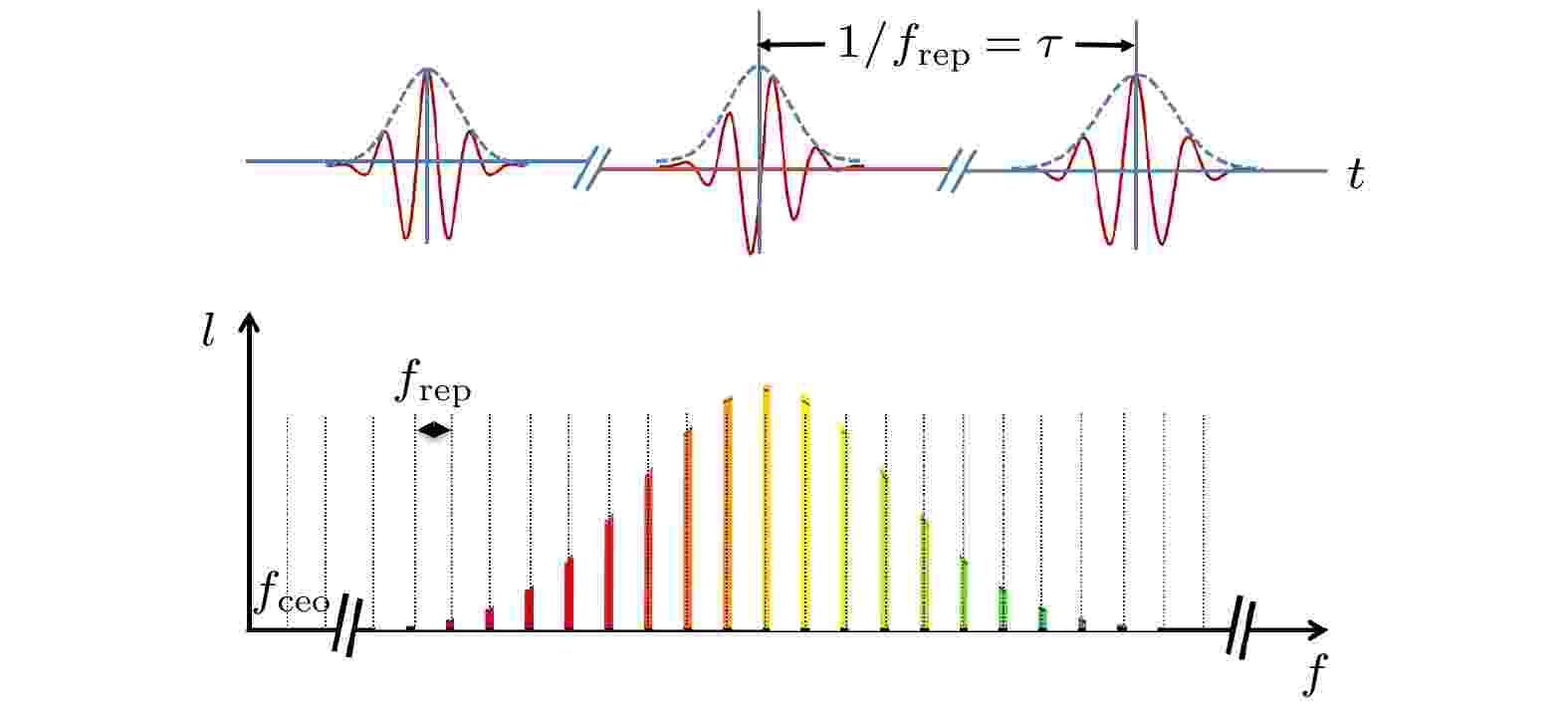
EDITOR'S SUGGESTION
2021, 70 (13): 134204.
doi: 10.7498/aps.70.20201925
Abstract +
Low noise microwave frequency has important applications in radar, long baseline interferometer and other fields. The phase noise of microwave signal generated by optical frequency comb is lower than –100 dBc/Hz at 1 Hz frequency offset and –170 dBc/ Hz at high frequencies (> 100 kHz), which is the lowest in the noise produced by all existing microwave frequency generation technologies. This paper introduces the basic principle of optical frequency comb generating microwave frequency, analyzes and summarizes various kinds of noise of microwave frequency signals and noise suppressing technologies. Then the low noise measuring methods are introduced, and several typical experimental devices generating microwave frequency and the obtained results are described. With the continuous improvement of optical frequency comb and noise suppression technology, microwave frequency source with very low noise will have wider application prospects and application fields.
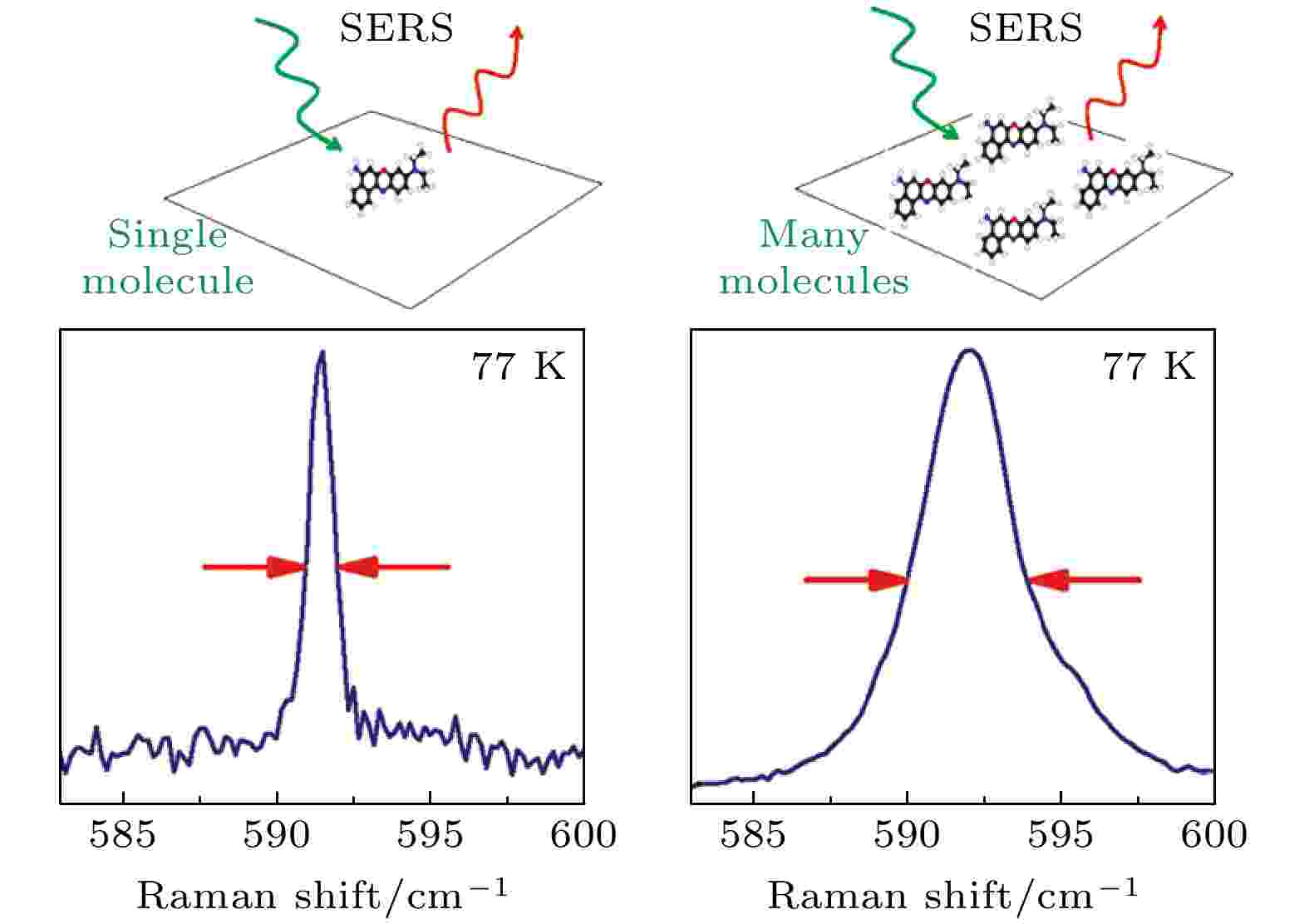
EDITOR'S SUGGESTION
2021, 70 (13): 137401.
doi: 10.7498/aps.70.20201447
Abstract +
Single-molecule detection (SMD), which represents the detection limit in molecular spectroscopy, has opened a new research realm in the fields of catalysis, DNA sequencing and protein analysis. Meanwhile, it provides new insights into the understanding of the molecule behaviors in a complex system. Specifically, SMD enables the quantitatively identifying of molecules accurate to single digit, provides the molecular distribution state under specific environments, and permits the in-situ observation of signal fluctuations of a single-molecule under chemical stimulus. Single-molecule surface-enhanced Raman spectroscopy (SM-SERS) is a new subject in SMD which features specific recognition of molecules by identifying the molecular chemical bonds. It is a non-destructive technology which reflects the vibration energy and rotational energy information of molecules. This technique employs metallic nanostructures to form surface plasmon resonances (SRP) under external excitation. The SPRs generate strong local electromagnetic fields ("hot spots") around metal surface to amplify the Raman signal of probe molecules in the vicinity of plasmonic materials. The giant field enhancement endows SERS superior sensitivity in trace molecule detection down to a single-molecule level. The SM-SERS offers a facile method to track the evolution of a single molecule, revealing the reaction pathways, adsorption state and distributions, and charge exchanges between the molecule and surrounding environment. Though SM-SERS has been proposed more than 20 years ago, the acquisition of SM-SERS spectra remains a bottleneck in this field due to the disability in judging the origins of these spectra. On the other hand, the lack of knowledge in analyzing SM-SERS spectra also limits the development of SM-SERS as the origins of molecule behavior at a micro level is basically unknown to the public. This review paper covers the development of SM-SERS, the past and current methods of verifying SM-SERS including the non-statistical and the bi-analyte statistical methods, the investigation into the understanding of the fluctuation characteristics of SM-SERS, as well as the related mechanisms with regard to the unique phenomena in SM-SERS such as molecule diffusion, spectral blinking and broadening. We hope this review can help the readers to relate the characteristics in SM-SERS with the origins of molecular variations during the detection, in this way to get a clear and in-depth understanding of the roadmap for SM-SERS.
GENERAL

2021, 70 (13): 130202.
doi: 10.7498/aps.70.20210017
Abstract +
Aiming at the uncertainty of the concentration of the pollution gases and the spread of distribution in the process of shale gas development, the open optical path Fourier Transform infrared spectroscopy (FTIR) measurement system designed and built by ourselves is used to invert the concentration of pollution gases in the backflow, and the size of pollution source is calculated by the flow rate of backflow liquid and the size of pollution source. By combining with the field environment and establishing the reference coordinates, the Gaussian diffusion model is derived mathematically, and the non-point source diffusion model of pollution source is constructed and simulated. The result shows that the source intensity, distance, wind speed and atmospheric stability all affect gas concentration diffusion. The concentration of main pollution gas and the strength of non-point source are obtained by continuously measuring the backflow liquid for 80 h. The result shows that C3H8, C5H12, C3H6, CO and SO2 are the main pollution gases of the backflow liquid, and their maximum concentrations are 4.689 mg/m3, 25.494 mg/m3, 30.324 mg/m3, 0.656 mg/m3 and 4.620 mg/m3, respectively. The maximum strengths of non-point source are 1.9872 g/s, 10.9750 g/s, 12.8513 g/s, 0.2707 g/s and 1.9064 g/s, respectively. By combining the wind speed and daytime environmental conditions, the atmospheric stability is selected and the source strength is substituted into the non-point source diffusion model, the diffusion concentration of polluted gas is obtained, and the real-time monitoring of the concentration distribution of different polluted gases at different locations is realized. The traditional method is used to collect air samples in the field and determine them in the laboratory. It takes a long time and different sampling methods are affected by the preservation time of samples, etc., so there is a great difference between the measured values in the laboratory and the measured values in the field. The country has issued online monitoring standards for volatile organic compounds (VOCs), but most of them are for the determination of non-methane total hydrocarbon, which cannot realize in situ component analysis, and cannot implement the monitoring of VOC concentration distribution within the region. Compared with traditional measurement methods, the method of FTIR and non-point source diffusion model can not only realize the non-contact, long-distance, online measurement of pollution sources, but also set the dynamic factory boundary of the pollution area and determine the safe distribution area.
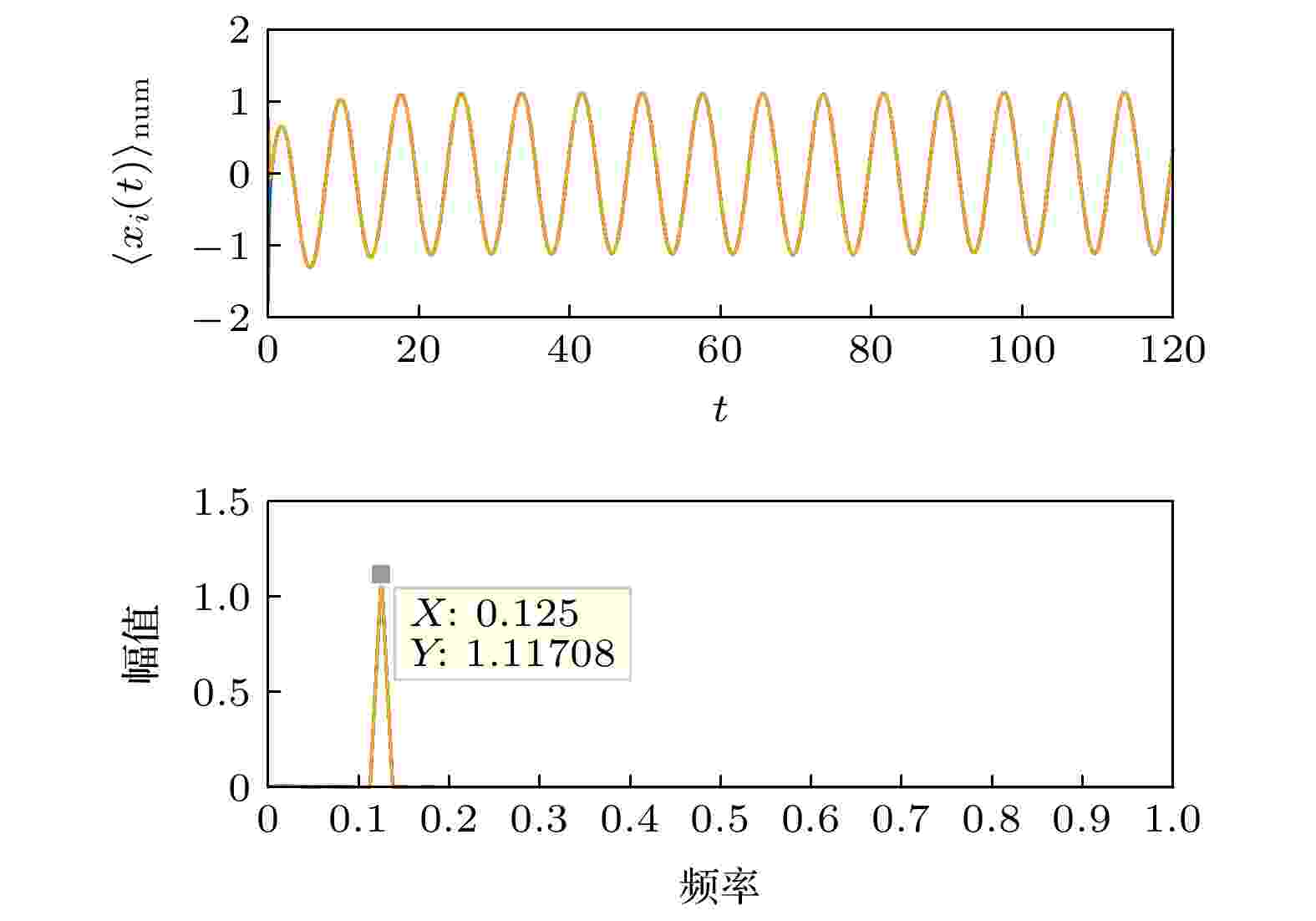
2021, 70 (13): 130501.
doi: 10.7498/aps.70.20210157
Abstract +
For multi-particle coupled systems, the effects of environmental fluctuations on each particle are often different in actual situations. To this end, this paper studies the collective dynamic behaviors in globally coupled harmonic oscillators driven by different frequency fluctuations, including synchronization, stability and stochastic resonance (SR). The statistical synchronicity between particles' behaviors is derived by reasonably grouping variables and using random average method, and then the statistical equivalence between behaviors of mean field and behaviors of single particle is obtained. Therefore, the characteristics of mean field's behaviors (that is, collective behaviors) can be obtained by studying behaviors of any single particle. Moreover, the output amplitude gain and the necessary and sufficient condition for the system stability are obtained by using this synchronization. The former lays a theoretical foundation for analyzing the stochastic resonance behavior of the system, and the latter gives the scope of adaptation of the conclusions in this paper. In terms of numerical simulation, the research is mainly carried out through the stochastic Taylor expansion algorithm. Firstly, the influence of system size N and coupling strength $\varepsilon$ on the stability area and synchronization time is analyzed. The results show that with the increase of the coupling strength $\varepsilon$ or the increase of the system size N, the coupling force between particles increases, and the orderliness of the system increases, so that the stable region gradually increases and the synchronization time gradually decreases. Secondly, the stochastic resonance behavior of the system is studied. Noises provide randomness for the system, and coupling forces provide orderliness for the system. The two compete with each other, so that the system outputs about the noise intensity $\sigma$ , the coupling strength $\varepsilon$ and the system size N exhibit stochastic resonance behavior. As the coupling strength increases or the system size increases, the orderliness of the system increases, and greater noise intensity is required to provide stronger randomness to achieve optimal matching with it, so as to the resonance of the noise intensity $\sigma$ , the peak gradually shifts to the right. Conversely, as the noise intensity $\sigma$ increases, the resonance peak of the coupling strength $\varepsilon$ and the system size N will also shift to the right.
THE PHYSICS OF ELEMENTARY PARTICLES AND FIELDS

EDITOR'S SUGGESTION
2021, 70 (13): 131301.
doi: 10.7498/aps.70.20202081
Abstract +
The accurate calibration of the beam energy of the circular electron-positron collider (CEPC) is performed to accurately measure the mass width of Higgs particle and the mass of W/Z boson, thus providing the basic experimental basis for the accurate test of the standard model. Based on this, the error control of beam energy is required to be at a level of 10–5. Compton backscattering method is suitable for high precision calibration of beam energy in the Hundred GeV high energy electron collider. In this work, the CEPC beam energy is predicted to reach a theoretical accuracy of about 3 MeV by using the accurate measurement of the scattered photon energy after microwave electron Compton backscattering. Firstly, TM01 mode microwave transmission in circular waveguide is selected according to the design requirements, and the electromagnetic field distribution and Poynting vector under this condition are solved. According to the photon distribution and transmission in the waveguide, the design idea is proposed to simplify the complexity of calculation, and the parameters conforming to the design requirements are solved by combining the simultaneous equations of the high purity germanium detector sensitivity and the background of synchrotron radiation. Using the optimal set of waveguide inner diameter, microwave wavelength and electron incident angle data, the derivative of the differential scattering cross section with respect to energy and the collision brightness are obtained when the microwave power is 100 W. The scattered photon density of 15 MeV energy is further obtained, and the signal-to-noise ratio is analyzed according to the photon density of synchrotron radiation under this energy. The feasibility of the scheme is demonstrated theoretically and the technical difficulties and problems to be further studied are discussed.
ATOMIC AND MOLECULAR PHYSICS
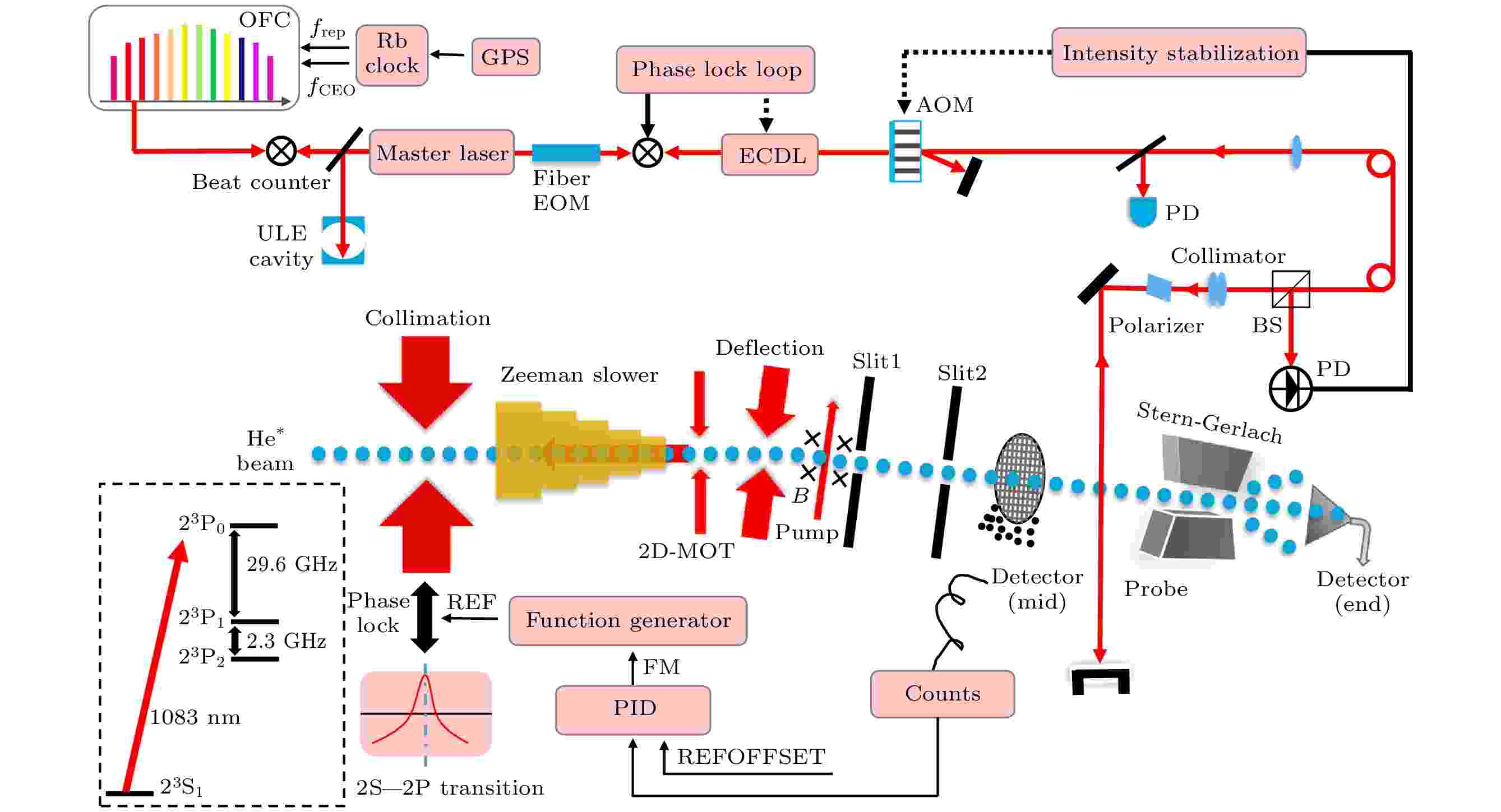
EDITOR'S SUGGESTION
2021, 70 (13): 133201.
doi: 10.7498/aps.70.20201833
Abstract +
A stable high-intensity atomic beam source plays a key role in many precision measurements. The precision spectroscopy of slow metastable ($2^3{\rm S}$ ) helium atoms is of great interest in testing quantum electrodynamics and determining the fine structure constant. By improving the source cavity structure and using laser cooling method, the beam flux is greatly enhanced. The added Zeeman slower reduces the longitudinal velocity of atoms, and at the same time increases the beam brightness of atoms at one single speed. Near the back end of Zeeman slower, a two-dimensional magneto-optical trap is added to collimate and focus the atomic beam. In addition, A beam stabilizing system is developed by using feedback control method. By changing the frequency of transverse cooling laser to change the cooling efficiency, the fluctuation of atomic beam intensity can be compensated in real time, and then the beam intensity can be stabilized at the target number. Experiments show that the continuous beam of metastable helium atoms at a velocity of $(100\pm 3.6)$ m/s has an intensity of $5.8\times10^{12}$ atoms/s/sr and a relative stability of 0.021%. In the experiment of precise spectral measurement based on atomic beam, the narrow longitudinal velocity distribution reduces the lateral Doppler broadening effect, and the lower longitudinal velocity also reasonably reduces the systematic error caused by the first-order Doppler effect. The atomic beam with such high intensity and stability in a single momentum and quantum state obviously improves the signal-to-noise ratio of the spectrum, and further reduces the statistical error of the results in the same detection time. Using this atomic beam, we demonstrated spectroscopy of the $2^3{\rm S}-2^3{\rm P}$ transition of $^4{\rm{He}}$ under the condition of only 0.1% of the saturated intensity. At this time, the full width at half maximum of the spectral peak is almost close to the natural line width, but the spectral signal-to-noise ratio is still better than 400 and the frequency shift caused by the detection laser power can be less than 1 kHz. This kind of spectral detection at low power can effectively reduce the power-dependent frequency shift, thus obtaining more reliable detection results. This metastable helium atom beam experimental system can also be used as a reference for similar precision measurement experiments.
ELECTROMAGNETISM, OPTICS, ACOUSTICS, HEAT TRANSFER, CLASSICAL MECHANICS, AND FLUID DYNAMICS
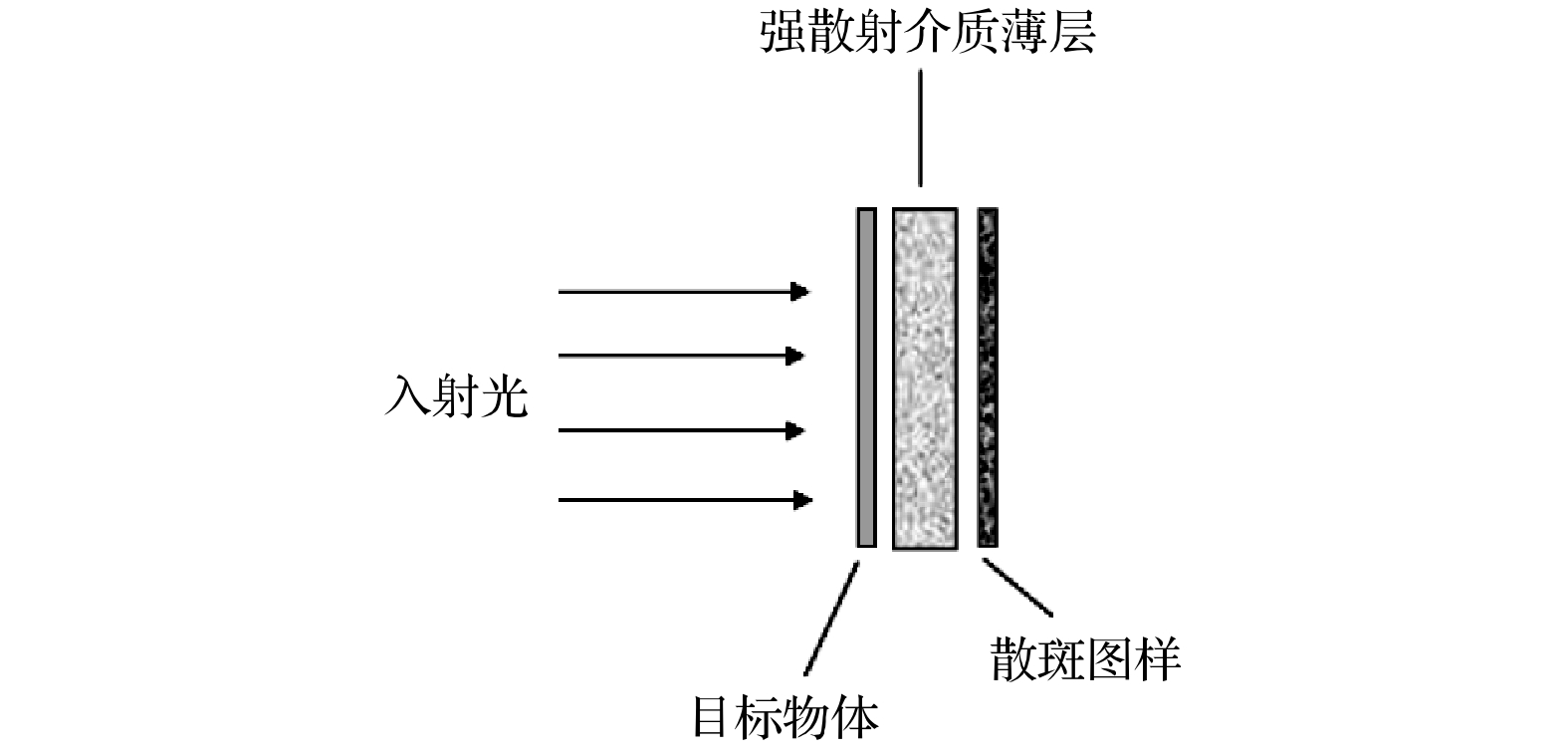
2021, 70 (13): 134201.
doi: 10.7498/aps.70.20201903
Abstract +
The scattering system through a highly scattering thin layer only affects the amplitude and phase distribution of incident light wave, but does not lead the total energy to be attenuated. This process can be regarded as a process that light wave is encoded by the scattering medium, which is similar to a double random phase encryption system. In this paper, firstly, it is proved that the distribution characteristics of speckle generated by the light wave carrying the target information through a strongly scattering thin layer are highly similar to the distribution characteristics of cyphertext obtained by the double random phase encryption system encrypting the same plaintext target. Therefore, the scattering system is seen as a double random phase encryption system, and the two random phase keys corresponding to the scattering system are calculated accurately by using the phase recovery algorithm. At the same time, it is proved that these two key boards can successfully reconstruct the original images corresponding to any other speckles obtained by the scattering system. Finally, a cyphertext-only attack method to attack a scattering system through a highly scattering thin layer is used to further prove the equivalence of two key boards and the good results are obtained. Since imaging through a scattering medium is an extremely complicated process, we actually simplify the corresponding process ideally. It should be noted that the equivalent system means that the incident-surface-to-exit-surface of scattering medium is equivalent to the incident-surface-to-exit-surface of DRPE system. However, in the actual process, there are still two diffraction processes: one is the diffraction process from the object to the incident surface and the other is the diffraction process from the output surface to the receiving surface. These two diffraction processes will cause the incident image and the output image of scattering medium to have a certain diffraction effect. We believe that under ideal conditions, due to the equivalence between the thin-layer strong scattering system and the DRPE system, theoretically all pure ciphertext attack methods applicable to the DRPE system can be applied to the speckle recovery of the thin-layer strong scattering system. In the future, it is possible to develop more methods of using system equivalence to crack the scattered light field. We hope this article can provide a new idea for scattering imaging.
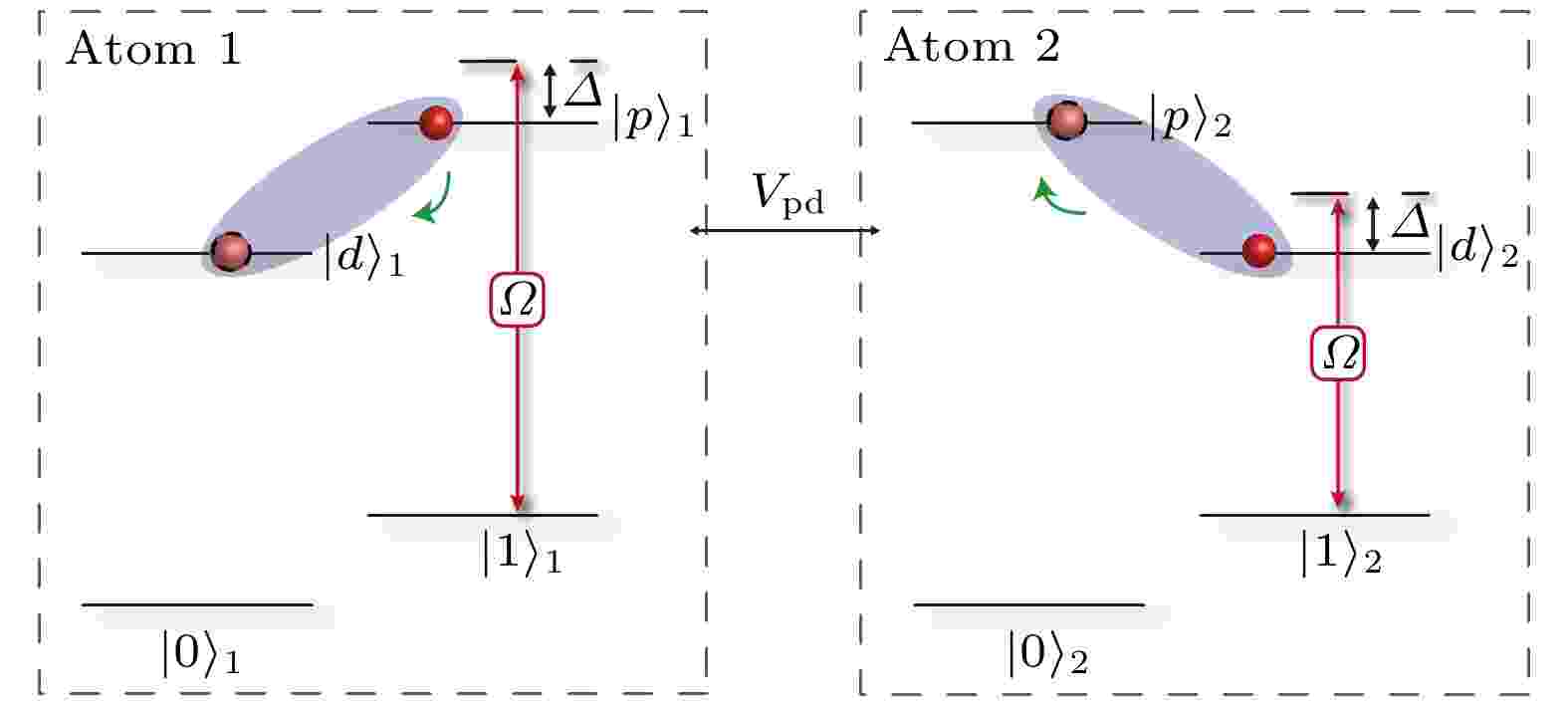
2021, 70 (13): 134202.
doi: 10.7498/aps.70.20210059
Abstract +
Quantum information science is an emerging field that applies the quantum coherence and correlation to cause the revolutionary advances in computation, communication, and fundamental quantum science. As an irreducible ingredient, Rydberg quantum gate is considered to be a powerful resource with great promises to a wide range of quantum information tasks far beyond the original gate proposals, since the remarkable features characterized by Rydberg atom are long lifetime and giant polarizability. In recent years, the research mainly focused on the properties of Rydberg atom, especially for the case where the effects of Rydberg blockade and antiblockade involving single level for each atom are dominated by van der Waals forces. However, with the variation of interatomic distance, Rydberg interactions can induce more complicated dynamical behavior. This paper studies the implementation of controlled-phase gate and swap gate in one step based on the constructed Rydberg antiblockade (RAB) and double antiblockade (RDAB) regimes when the interatomic distance is less than the characteristic length. Different from the conventional RAB regime that requires weak Rydberg-Rydberg interaction (RRI), our attainable strategy is to compensate the RRI-induced energy shift by properly tuning the detuning between the driving field and atomic transition frequencies. In addition, the proposed RDAB mechanism is a new physical insight that can enable two pairs of Rydberg states belonging to different atoms to be excited, simultaneously. In contrast to other blocking schemes or the schemes without requirements for strong interactions, the merits of our proposal lies in the strong dipole-dipole interaction between two atoms, leading to the population exchange of multiple energy levels. Numerical simulations show that the time evolution of the population for collective double-atom basis obtained from the original Hamiltonian agrees well with the analytical results given by the effective Hamiltonian. In the ideal case, the average fidelity of the controlled-phase (swap) gate can reach 99.35% (99.67%) at final time $t=\sqrt{2}\pi\Delta/\Omega^{2}$ ($t=2\pi\Delta/\Omega^{2}$ ), and our protocol is robustness against spontaneous emission of high-lying Rydberg states. We believe our present investigation is feasible in upcoming experimental realization and may offer an new venue with respect to on-demand design of new types of effective Rydberg quantum gate devices.
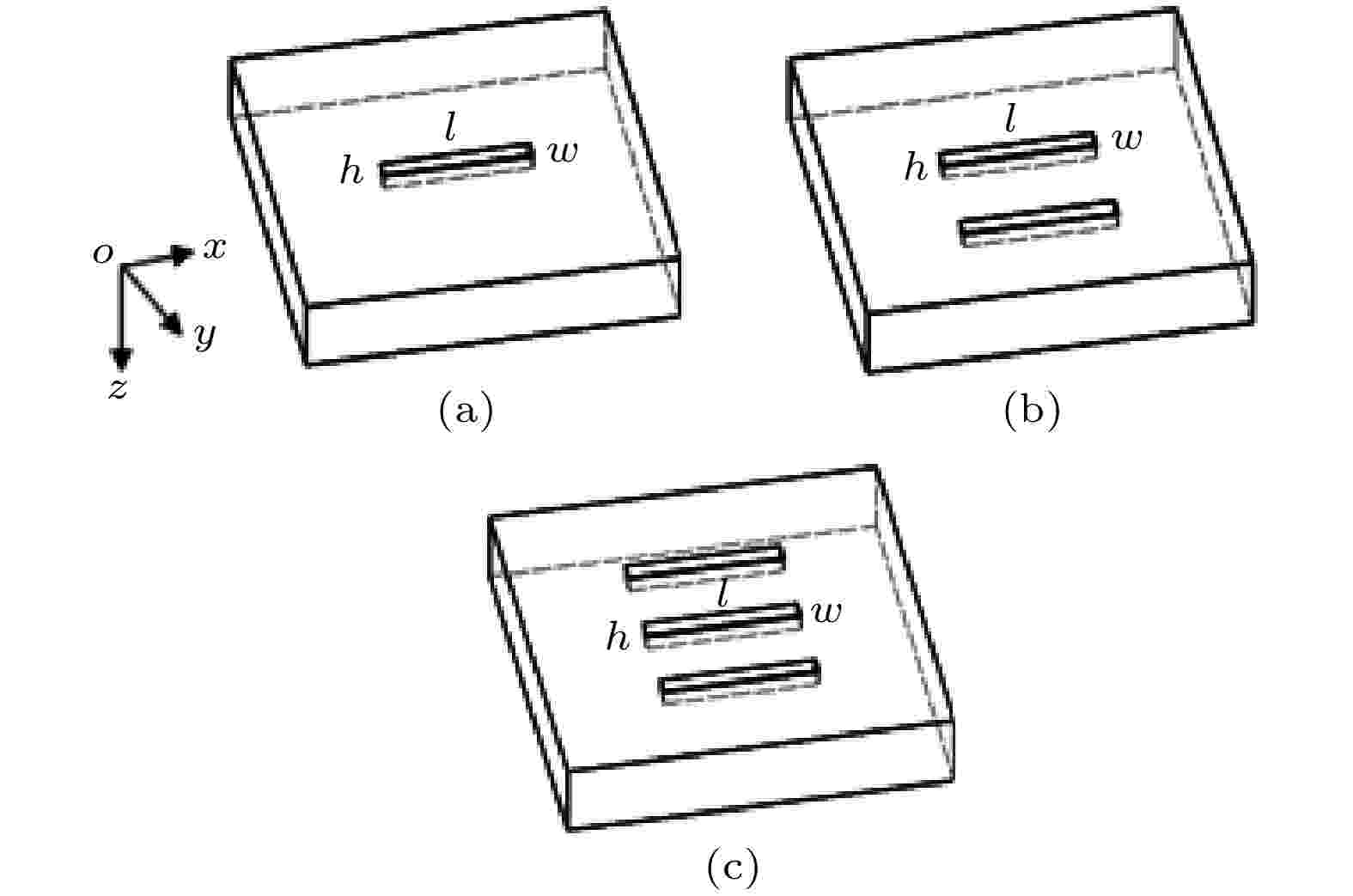
2021, 70 (13): 134203.
doi: 10.7498/aps.70.20202174
Abstract +
When a laser beam irradiates an optical material, a light standing wave field should be observed inside the optical material due to the interference between the beam reflected from the rear surface and the incident beam. If there are scratches on the surface, the incident light can be modulated and the distribution of the standing wave field inside the material is not uniform any more. Therefore, the appearance of the local enhancement of light will change the damage characteristics of optical material. To analyze the field damage characteristics of optical material with scratches, a theoretical analysis model is established. It can be used to study the damage characteristics and build a priori model of actual optical material. Fused quartz is employed as the study object, and the modulation effect of defect on light field is simulated by finite difference time domain (FDTD). Based on the electron multiplication theory, the effect of the number and the positions of scratches on the damage characteristics of fused quartz are calculated in detail. The results show that the phase modulation of the scratch will destroy the uniformity of the standing wave field when the scratch defect material is irradiated by laser. Due to the influence of the standing wave field, the maximum field intensity appears near the rear surface of the material, which explains the phenomenon that the rear surface of the material is more prone to damage points. When there are multiple scratches on the material surface, the distribution of light field is related to the number of the scratches. Specifically, the maximum field intensity increases with the number of scratches increasing. Taking fused quartz material for example, when a 10-ps pulse is incident on it, if three scratches are located on its surface, then the modulation effect on the light field is strongest, and the damage threshold is 66.1% lower than that of the ideal material. In addition, the scratch spacing also has an effect on the standing wave field and field damage characteristics of the material, and the specific effect of the interval can be analyzed directly by using the calculation model proposed in this paper.
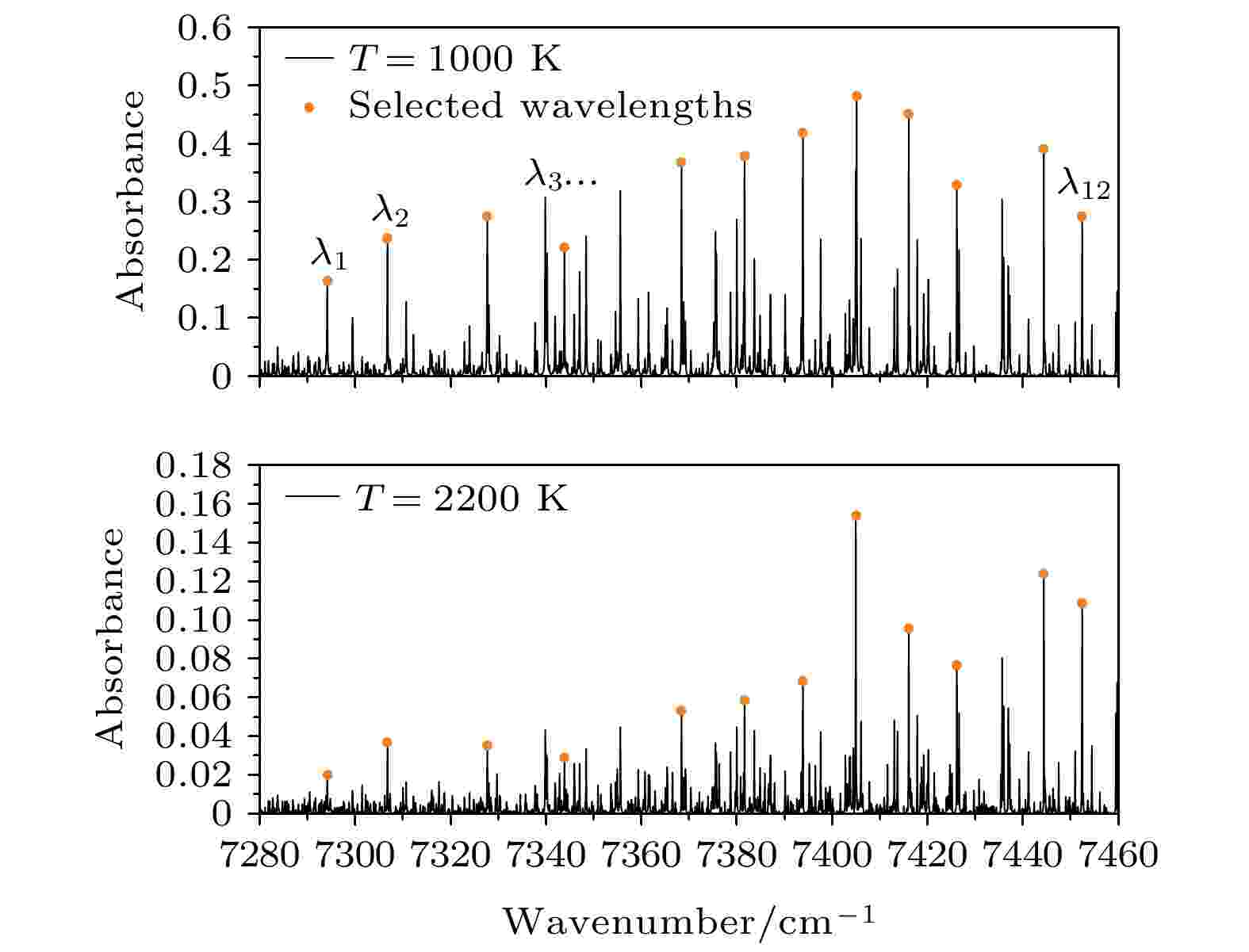
2021, 70 (13): 134205.
doi: 10.7498/aps.70.20202124
Abstract +
In this paper, a method of selecting the optimal transition lines’ combination is analyzed to measure the absorption spectrum of the non-uniform combustion flow field, which is used to solve the basic two-region distribution, and an improved simulated annealing algorithm (ISA) is proposed for reconstructing the field distribution of the combustion flow field, in order to solve the problems of slow convergence speed and low efficiency of the traditional simulated annealing algorithm. By modifying the model perturbation mode and annealing strategy, the efficiency of the algorithm and the chance to jump out of the local optimal space are further improved. According to the numerical simulation results, more transitions are helpful in improving the accuracy of combustion field reconstruction and making the reconstruction less sensitive to noise. It is worth noting that the optimal transitions’ combination is better than the non-optimal transitions’ combination with more transitions included. In this paper, three different combustion models are constructed to verify the effectiveness of the improved algorithm. A comparison between the reconstruction results of the traditional simulated annealing algorithm and the improved simulated annealing algorithm shows that both algorithms have the same precision but the latter algorithm has a higher operating efficiency, and a faster running time (nearly 40 times faster than the former algorithm). At the same time, the simulation results also show that the reconstruction accuracy will decrease slightly with the complication of combustion flow field. By building the TDLAS-HT measurement system in the laboratory and using 8 × 8 orthogonal optical path arrangement, the two different combustion states formed before and after placing the steel rod in the flat flame furnace are reconstructed, the results show that the reconstruction distribution is basically consistent with the original distribution, and the reconstructed distribution well shows the combustion characteristics of the original distribution of the flame field. The effectiveness of the proposed method is verified by numerical simulation and verification tests. Under the condition of the same reconstruction accuracy as the reconstruction accuracy of the traditional simulated annealing algorithm, the higher operating efficiency is helpful in reconstructing the rapidly changing turbulent field, which has some guiding significance for the hyperspectral reconstruction of temperature and concentration distribution in the combustion flow field.

EDITOR'S SUGGESTION
2021, 70 (13): 134206.
doi: 10.7498/aps.70.20201704
Abstract +
As a major component in the air, nitrogen emits fluorescence when it interacts with intensive laser field. The fluorescence comes from the first negative band system (${{\rm{B}}^{{2}}}\Sigma _{\rm{u}}^{{ + }} \to {{\rm{X}}^{{2}}}\Sigma _{\rm{g}}^{{ + }}$ transition) of ${\rm{N}}_{{2}}^{{ + }}$ and the second positive band system (${{\rm{C}}^{{3}}}\Pi _{\rm{u}}^{{ + }} \to {{\rm{B}}^{{3}}}\Pi _{\rm{g}}^{{ + }}$ transition) of ${{\rm{N}}_{{2}}}$ . Under the action of high-intensity femtosecond laser, ${{\rm{N}}_{{2}}}$ can be directly photo-ionized into ${\rm{N}}_{{2}}^{{ + }}{{(}}{{\rm{B}}^{{2}}}\Sigma _{\rm{u}}^{{ + }})$ , which results in fluorescence emission of ${\rm{N}}_{{2}}^{{ + }}$ . In the process of femtosecond laser filament formation, the dynamic processes such as ionization and excitation of nitrogen molecules are affected by the laser intensity distribution and laser polarization direction. The products show different distributions in the propagation direction and radial space, which, in turn, affects its light emission. Therefore, it is necessary to further ascertain its generation mechanism through the spatial distribution of nitrogen fluorescence. In this experiment, the spatial distribution of the nitrogen fluorescence emission generated by linearly polarized femtosecond laser pulse filaments in air is measured. By changing the polarization direction of the laser to study the distribution of nitrogen fluorescence in the radial plane, it is found that the fluorescence emission of ${\rm{N}}_2^ + $ is more intense in the direction perpendicular to the laser polarization, while it is weaker in the direction parallel to the laser polarization. The nitrogen fluorescence emission has the same intensity in all directions. The ionization probability of a linear molecule depends on the angle between the laser polarization direction and the molecular axis, which is maximum (minimum) when the angle is ${{{0}}^{\rm{o}}}$ (${{9}}{{{0}}^{\rm{o}}}$ ). The ${{\rm{N}}_{{2}}}$ gas is more likely to be ionized in the laser polarization direction, the nitrogen molecular ions ${\rm{N}}_{{2}}^{{ + }}$ and electrons are separated in the direction parallel to the laser polarization. Therefore, more ions (${\rm{N}}_{{2}}^{{ + }}$ ) are generated in the direction parallel to the laser polarization, and the fluorescence emission of ${\rm{N}}_{{2}}^{{ + }}$ is more intense. Along the propagation direction of the laser, it is found that the fluorescence of ${{\rm{N}}_{{2}}}$ appears before the fluorescence of ${\rm{N}}_2^ + $ and disappears after the fluorescence of ${\rm{N}}_{{2}}^{{ + }}$ has vanished. This is due to the fact that ${{\rm{N}}_{{2}}}$ can be ionized into ${\rm{N}}_{{2}}^{{ + }}{{(}}{{\rm{B}}^{{2}}}\Sigma_{\rm{u}}^{{ + }})$ at the position of high enough laser intensity, thus emitting fluorescence of ${\rm{N}}_2^ + $ . However, the laser energy is not enough to ionize nitrogen at the beginning and end of laser transmission, but it can generate ${\rm{N}}_2^ * $ , which emits nitrogen fluorescence through the process of intersystem crossing ${\rm{N}}_2^*\xrightarrow{{{\rm{ISC}}}}{{\rm{N}}_2}({{\rm{C}}^3}\Pi _{\rm{u}}^ + )$ . The spatial distribution of nitrogen fluorescence emission during femtosecond laser filament formation shows that in the case of short focal length, the intersystem crossing scheme can explain the formation of ${{\rm{N}}_{{2}}}{{(}}{{\rm{C}}^{{3}}}\Pi _{\rm{u}}^{{ + }})$ . This research is helpful in understanding the mechanism of nitrogen fluorescence emission.

2021, 70 (13): 134208.
doi: 10.7498/aps.70.20201575
Abstract +
Modulation transfer function (MTF) measurement is a major means to evaluate the imaging quality of a space camera. The influence caused by the spectral characteristic of light source on the MTF results is not negligible, because the transmittance and color aberration of optical systems, and quantum efficiency of the space camera detectors are all spectrally related. Thus, MTF results tested by different light sources are different from each other. To address this problem, we propose a method to analyze the influence of spectral characteristics of light sources on measuring the MTF of space cameras. In addition, the devices and methods are designed to calibrate the spectral response and monochrome point spread function (PSF) of space camera. A Sigma lens (focal length: 1000mm, F number: 5.6) and a Cannon EOS 5DSR camera (pixel size: 4.14 μm) are combined into an experimental space camera, whose spectral response is calibrated with a monochromator (Omno30300, NBeT) and a spectral radiometer (FieldSpec, ASD). We calibrate the monochrome PSF of the Sigma lens with the same monochromator and a CCD (PIXIS 1024, Princeton Instruments, pixel size: 13 μm) micro-measuring system (20X objective). During the calibration of spectral response and monochrome PSF, the same collimator (focus: 5000 mm, F number: 10) is used. With using the proposed method and those calibrating data, we compute the theoretical values of the MTF of a space camera measured separately with five different light sources. The results indicate that MTF measured by a xenon lamp is greatly different from those MTFs measured by the other four light sources. Comparisons of those theoretically calculated MTFs, separately, show that the MTF measured by a tungsten halogen lamp is greater than the MTF measured by a xenon lamp at each spatial frequency. The deviation between those two lamps reaches a maximum value of 0.075 in the medium-high frequency zone. Furthermore, in order to verify those theoretical conclusions, a platform including a collimator and the previous space camera is constructed. The MTFs measured by a tungsten halogen lamp and a xenon lamp are computed with the slanted-edge method respectively. The results demonstrate that the distributions and deviations of the MTFs tested by those two lamps are identical to those theoretical results at each spatial frequency, with the maximum deviation being 0.057. The theoretical and experimental results demonstrate that the suggested method can accurately calculate the influence of spectral characteristics of light sources on measuring MTF of space cameras. The proposed method can also be adopted to investigate the influence of spectral characteristics of light sources on MTF of optical systems in the design or test stages.
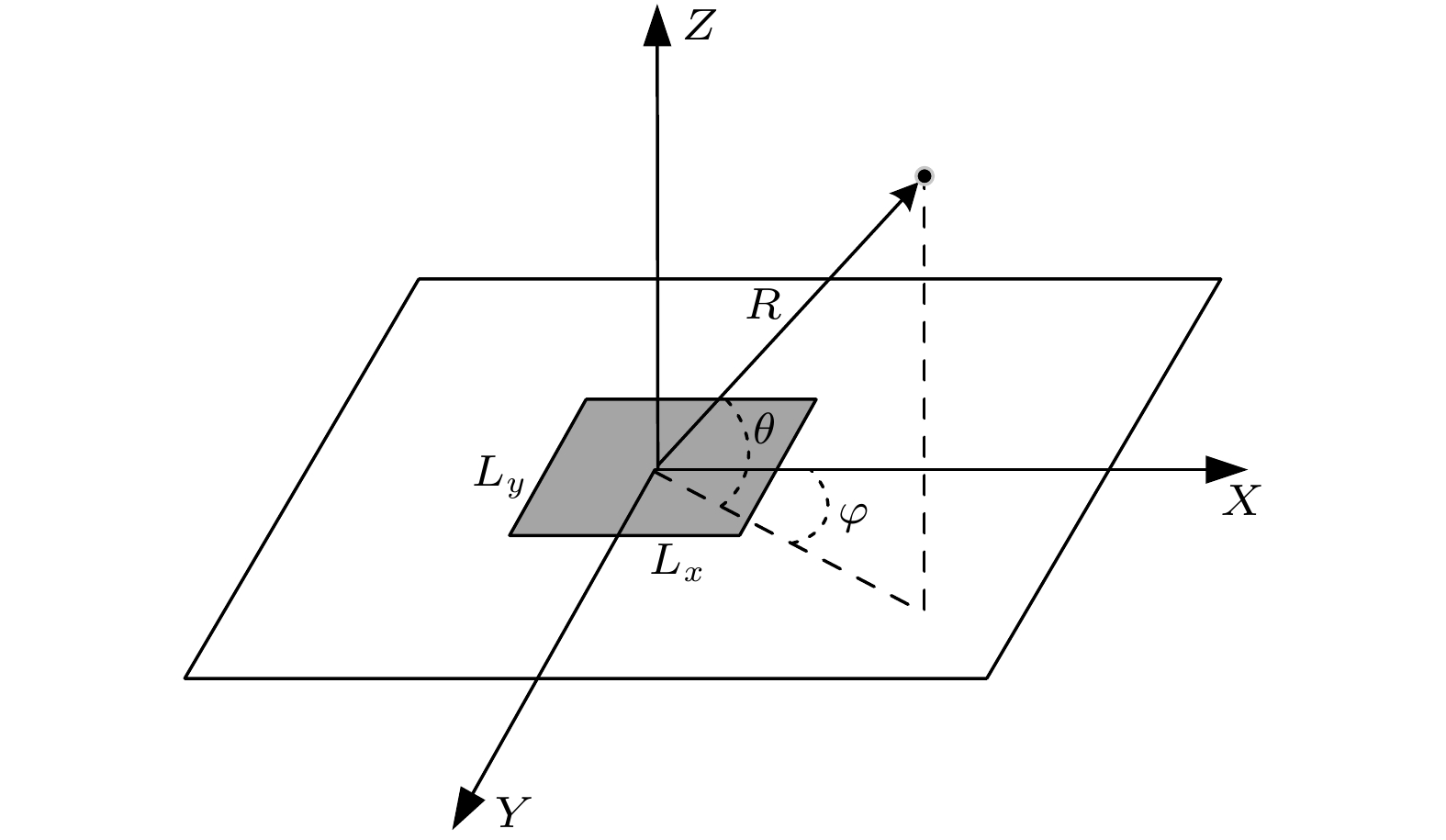
2021, 70 (13): 134301.
doi: 10.7498/aps.70.20201971
Abstract +
In order to improve the sound field reconstruction accuracy of distributed structural source, a new near-field acoustic holography is established based on the element radiation superposition method (ERSM). In the proposed method, the surface of structural source is divided into several regular pistons. The sound field of structural source is considered as the superposition of sound field of pistons. Firstly, we compare the sound field calculated by ERSM with that by Rayleigh's integral. It is proved that ERSM is quite accurate in sound field prediction. Based on ERSM, a vibration acoustic transfer (VAT) function is derived. The VAT function has computable analytical expression and embodies the transfer relationship between the structural source surface and the radiated sound field. The VAT function can precisely characterize the acoustic propagation of continuous distributed coherent sources. Subsequently, we employ the VAT function to replace the Green's function, and apply the VAT function to sound field reconstruction. Different with the equivalent source method (ESM) which is widely used in sound field reconstruction, ERSM directly divides the piston-sources on the surface of structural source rather than constructing the equivalent point-sources on a plane behind the structural source. Furthermore, we introduce a weight matrix into ERSM and iteratively calculate the vibration velocity for a more accurate result, and we call the proposed method as iterative weighted ERSM (IWERSM). In this paper, the simulations and experiment of sound field reconstruction of a rectangular plate are performed. In the proposed method, the rectangular plate is divided into several rectangular pistons. The reconstruction results of ERSM and IWERSM are compared with that of ESM and iterative weighted ESM (IWESM) respectively. The reconstruction accuracies at different distances between the plate and array (test distances) are analyzed. The simulation results show the accuracy of ERSM and IWERSM are better than that of ESM and IWESM respectively. With the increase of test distance, the phenomenon is more obvious, and IWERSM even shows a good reconstruction accuracy while the test distance is more than half a wavelength. The experiment results also validate that ERSM and IWERSM have better reconstruction accuracy than ESM and IWESM respectively at the same test distance. In a word, the simulations and experiments demonstrate that the proposed method can improve the sound field reconstruction accuracy of regular structural source and expand the valid test distance of near-field acoustic holography.
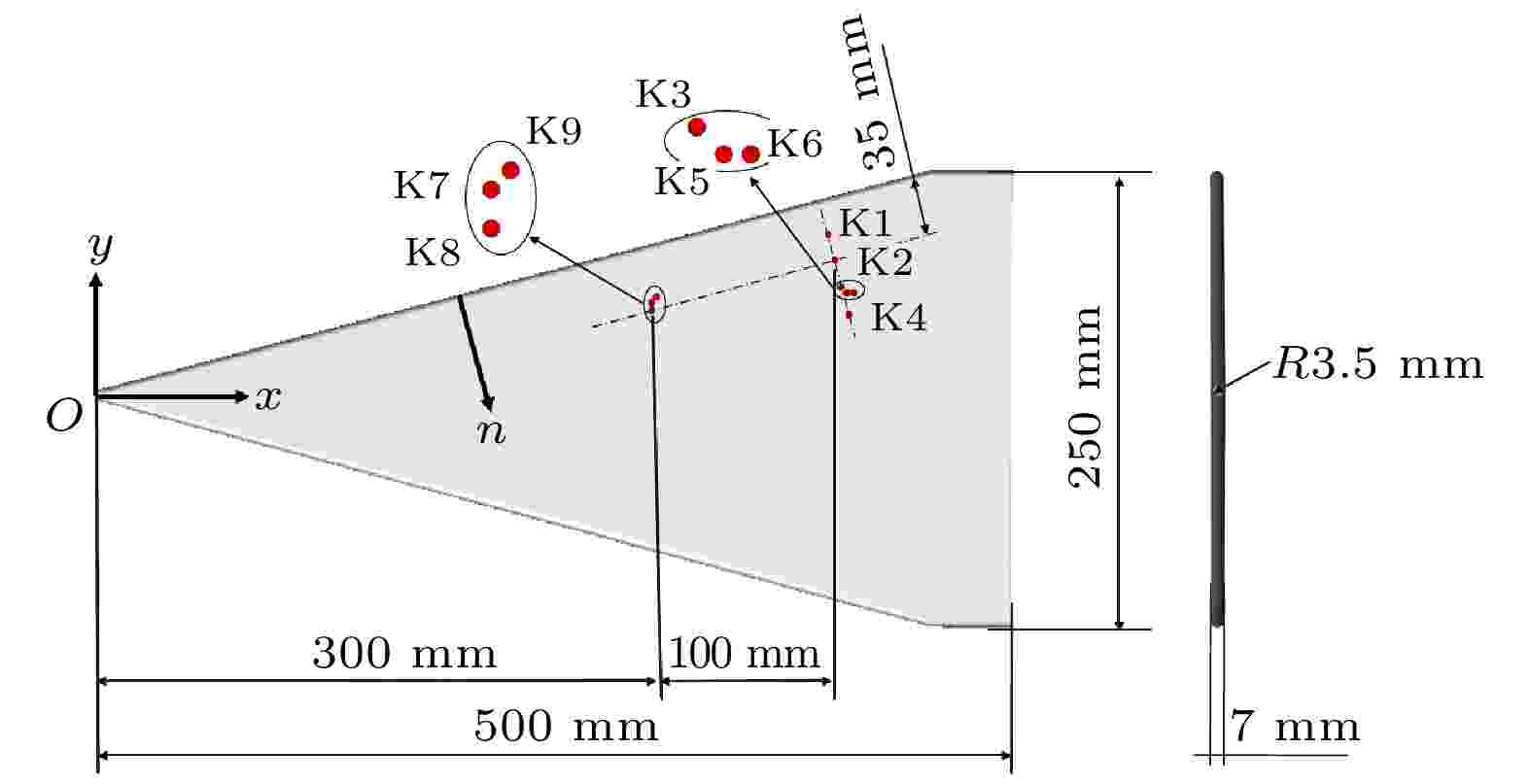
2021, 70 (13): 134701.
doi: 10.7498/aps.70.20201777
Abstract +
In this paper, the traveling crossflow instability in the boundary layer on the windward side of a delta wing is studied. The experiments are carried out in a Mach 6 low-noise wind tunnel, with the angles of attack of the model being 5° and 10°, and the Reynolds number being in a range of 2.43 × 106–14.21 × 106 m–1. The wall fluctuation pressure is measured by fast-response Kulite pressure transducers. The power spectrum density (PSD) analysis is conducted to obtain the disturbance waves' development process in the boundary layer. The temperature-sensitive paints (TSPs) and nano-tracer based planar laser scattering (NPLS) technique are also used. From the TSP results, the boundary layer transition near the leading edge of the delta wing is smooth and parallel to the leading edge. A peak around 10 kHz in power spectrum density is detected by the fast-response pressure sensor, which may be caused by the traveling crossflow waves. To verify this dominant mode, an NPLS image in the plane of n = 36 mm is obtained. The shapes of vortex structures correspond to the shapes of the crossflow vortices from the numerical simulation. Only when the boundary layer is laminar can the traveling crossflow wave signal be observed from the PSD curves. When the boundary layer is at a transitional or turbulent phase, the low-frequency component is dominant in the PSD curve. With the increase of Reynolds number, the characteristic frequency of the crossflow wave increases, and the wave’s amplitude first increases and then decreases. Moreover, the angle of attack effect is obtained. The increasing of the angle of attack can make the traveling crossflow wave grow faster and saturate, attenuate at the position closer to the leading edge of the delta wing or at a lower Reynolds number. By sensor pairs composed of three Kulite transducers, the phase velocity and the propagation angle of the traveling crossflow wave are investigated. The dimensionless phase velocities of the traveling wave are in ranges of 0.24–0.26 and 0.26–0.32 at 5° and 10° angles of attack, respectively. The propagation angles are at 50°–60° and 40°–55° at the angles of attack of 5° and 10°, respectively. At a larger angle of attack, the traveling wave’s propagation angel is smaller, but the phase velocity is bigger. It may be because the spanwise pressure gradient is higher at a larger angle of attack, and then the crossflow velocity is stronger.

2021, 70 (13): 134702.
doi: 10.7498/aps.70.20210058
Abstract +
The nanobubbles contained in the human body are induced to collapse by the shock wave, and thus produce a strong impact and high-speed nanojet, resulting in trauma to human tissues. The collapse of nanobubbles in water caused by shock waves is investigated by molecular dynamics. Nanobubbles are divided into three types: vacuum nanobubble, carbon dioxide nanobubble, and oxygen nanobubble. The influence of factors such as the number of gas molecules, the diameter of the nanobubbles, and the impulse of the shock wave on the bubble collapse are considered separately. The results show that the addition of gas molecules to vacuum nanobubbles does not affect the propagation of shock waves. However, before the nanobubbles are completely collapsed, the maximum velocity of the nanojet formed by the collapse of nanobubbles containing 718 carbon dioxide molecules (or 733 oxygen molecules) is larger than that of vacuum and nanobubbles containing 1368 carbon dioxide molecules (or 1409 oxygen molecules). After the nanobubbles are completely collapsed, the gas molecules cause the velocity of the nanojet to decay, and finally the maximum velocity of the nanojet containing gas molecules is less than that of the vacuum nanojet. In addition, it is also found that the collapse time of nanobubbles is short at high impulse, and the density and pressure when the shock wave passes at the same time are both greater. After the bubble collapses, the maximum velocity of the nanojet is larger, and the impact force is much stronger than that at a small impulse. Larger diameter nanobubble has a longer collapse time, and the density and pressure when the shock wave passes at the same time are both smaller, and the shock wave propagation is slower, but the maximum speed of the nanojet is larger. The impact is stronger. The greater the maximum velocity of the nanojet, the greater the distance that is dispersed by the gas molecules of the gas-containing nanobubbles in the impact direction will be and the deeper the depression.
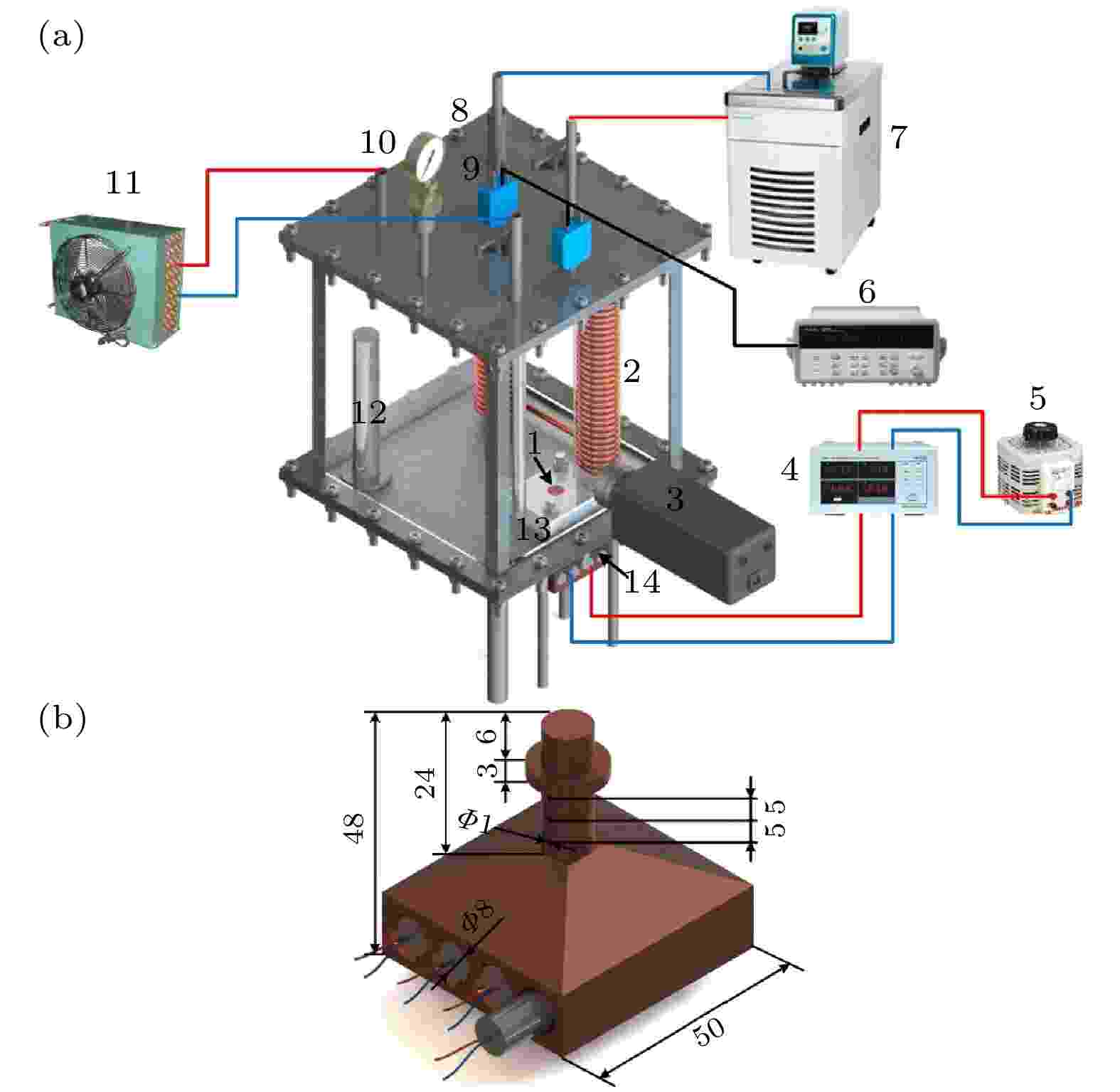
2021, 70 (13): 134703.
doi: 10.7498/aps.70.20202053
Abstract +
Pool boiling is a high-efficient energy transfer method through the gas-liquid phase transition. It has the characteristics of small heat transfer temperature difference and high heat flux density. The current enhancement of boiling heat transfer is realized mainly through modifying the solid heating surface. So far, there has been no report on the study of pool boiling heat transfer on soft surfaces. Therefore, in this work the pool boiling heat transfer performances of ethanol on the copper surface and soft liquid metal surface are investigated experimentally. The experimental results indicate that soft surface can effectively reduce the wall superheat corresponding to the onset of boiling (ONB). In saturation boiling, the superheat of the wall surface at ONB is reduced by nearly 12 ℃, while the heat transfer coefficient is improved by 149%. It is found that soft surface enhances pool boiling heat transfer performance significantly by increasing nucleate site density, reducing the bubble departure diameter, and increasing bubble departure frequency. Unlike the copper surface, the soft surface deforms elastically under the action of the vertical component of surface tension γlvsinθ at the three-phase contact line of the vapor bubble. From the perspective of surface energy analysis, the difference in surface energy ΔELM between before and after bubble departure on soft liquid metal surface is smaller than in smooth surface ΔECS. The potential barrier of the soft surface is smaller than of the copper surface, and the buoyancy required for bubble separation is small, and the bubble is easy to separate. Elastocapillary wave and bubble jet phenomenon on the soft surface are observed particularly, which are generated on liquid metal under the action of elastic restoring force. The fluctuation of elastocapillary wave contributes to the enhancement of heat and mass transfer in thermal boundary layer and the generation of residual nucleation site. The residual bubble grows up rapidly and coalesces with the rising large bubble, forming bubble jet phenomenon. Elastocapillary wave and bubble jet contribute to the enhancement of pool boiling heat transfer on soft liquid metal surface.
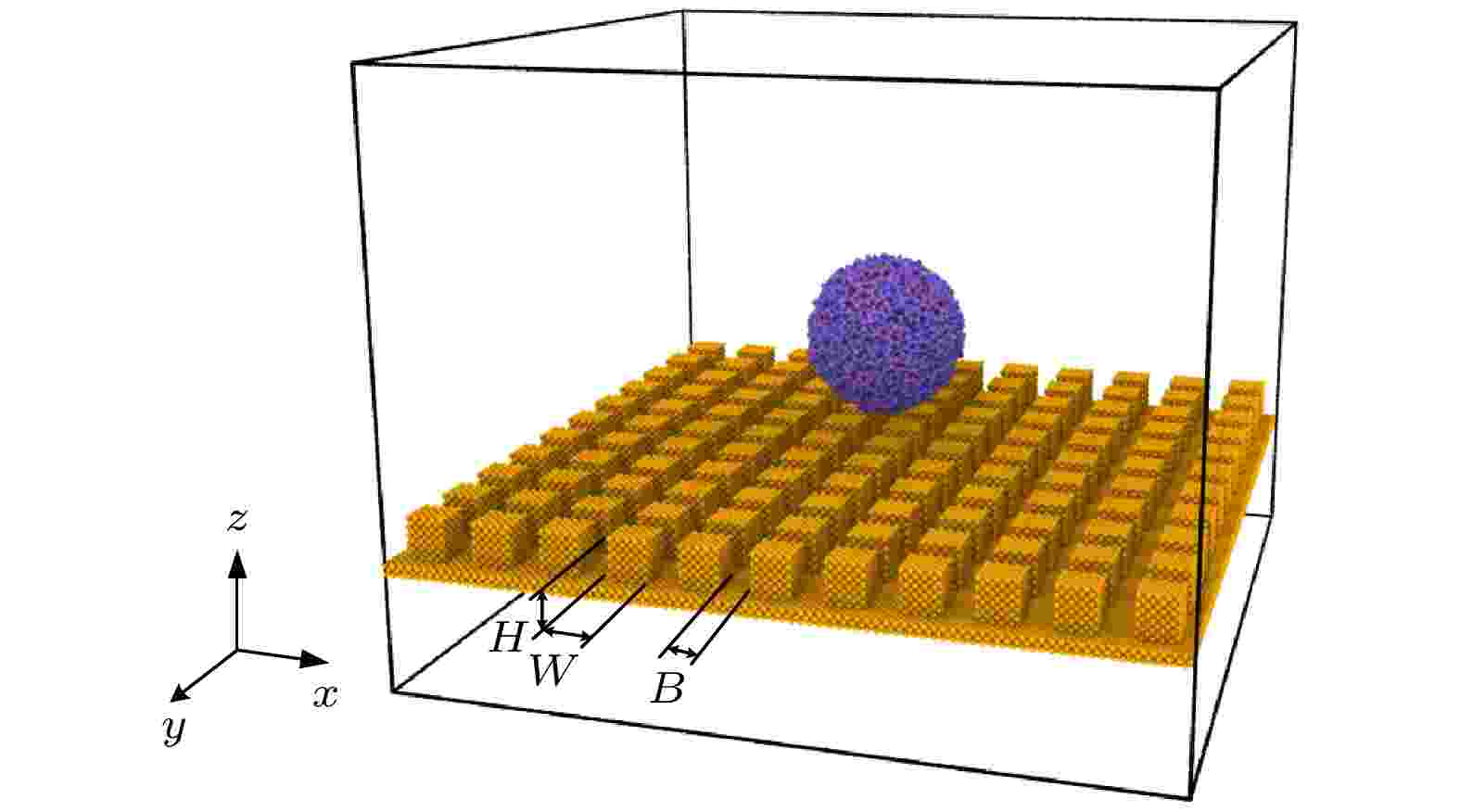
2021, 70 (13): 134704.
doi: 10.7498/aps.70.20210094
Abstract +
Droplets’ impinging on a solid surface is a common phenomenon in industry and agriculture. With the development of micro and nano technology, the quantitative descriptions of impinging behaviors for nanodroplets are expected to be further explored. Molecular dynamics (MD) simulation is adopted to investigate the behaviors of water nanodroplets impinging on cooper surfaces which have been decorated with square nanopillars. The dynamical characteristics of nanodroplets are analyzed at 5 different pillar heights, 6 different surface characteristic energy values, and a wide range of droplet velocities. The results show that there is no obvious difference among the dynamical behaviors for nanodroplets, whose radii are in a range from 35 to 45 Å, impinging on a solid surface. With the increase of droplet velocity, the wetting pattern of steady nanodroplets first transfers from Cassie state (V0 = 2–3 Å/ps) to Wenzel state (V0 = 4–10 Å/ps), then it returns to the Cassie state (V0 = 11–13 Å/ps) again. Nanodroplets bounce off the solid surface when V0 > 13 Å/ps. The relationship between the maximum spreading time and droplet velocity is presented. Inflection points in the curve of the relationship are discovered and their formation mechanism is studied. The spreading factors of steady states for nanodroplets with velocity lower than 9 Å/ps are nearly the same; however, they decrease gradually for nanodroplets with velocity higher than 9 Å/ps. In addition, the increasing height of square nanopillars facilitates the transition from Wenzel state to Cassie state and reduces the spreading radius of steady nanodroplets. The mechanism, which yields Wenzel state when the nanodroplets impinge on solid surface with lower height nanopillars, is investigated. In the spreading stage, spreading radii of nanodroplets impinging on surfaces with different height nanopillars are almost identical. The influence of nanopillar height mainly plays a role in the retraction stage of droplets and it fades away as the height further increases. Moreover, the higher surface characteristic energy benefits the spreading of nanodroplets and reduces the retraction time. Especially, nanodroplets do not experience retraction stage, and the spreading stage is kept until the nanodroplets reach a stable state when the surface characteristic energy is increased to 0.714 kcal/mol. Compared with the spreading factor, the centroid height of nanodroplet is very sensitive to the change of surface characteristic energy.
PHYSICS OF GASES, PLASMAS, AND ELECTRIC DISCHARGES
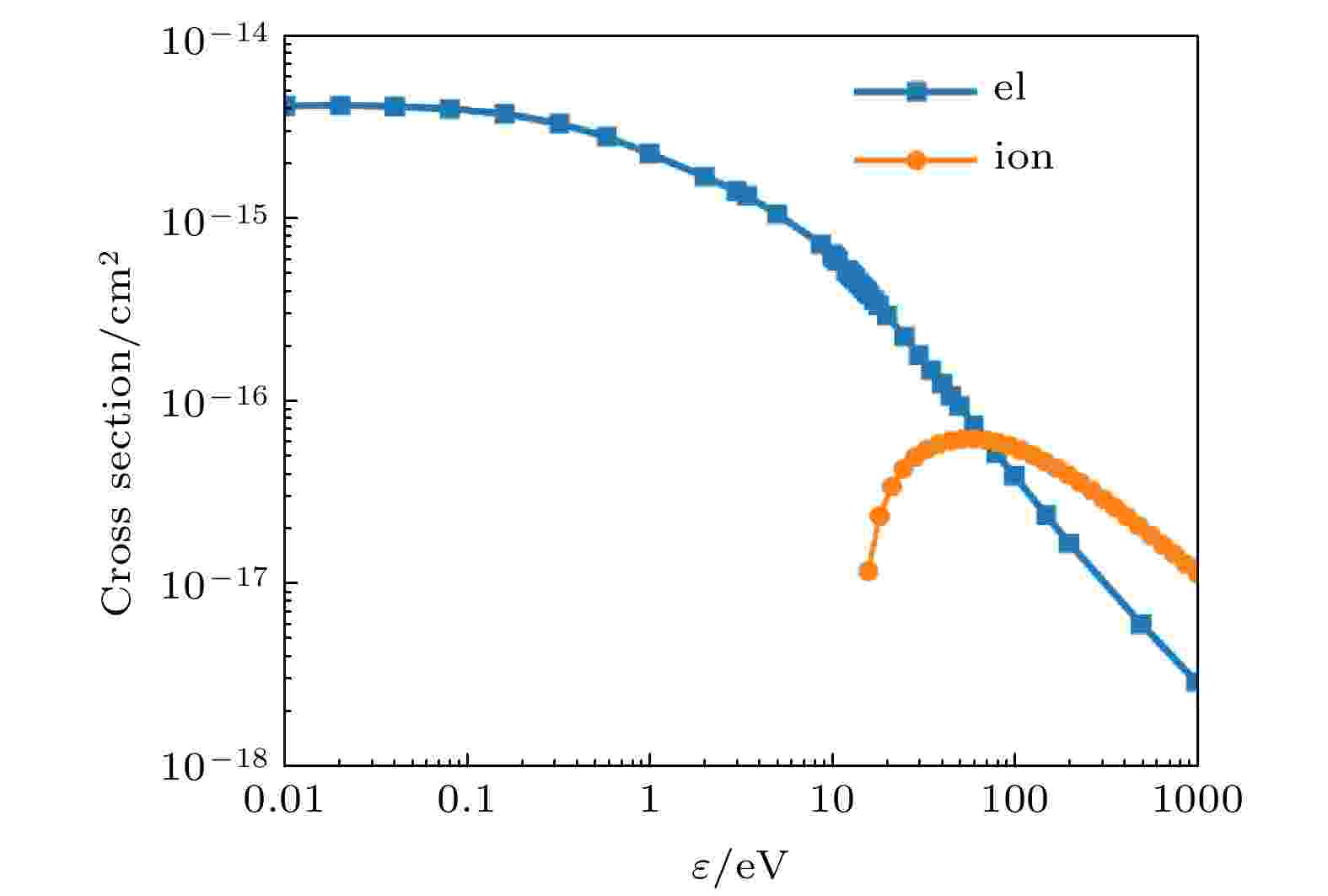
EDITOR'S SUGGESTION
2021, 70 (13): 135101.
doi: 10.7498/aps.70.20202021
Abstract +
The veracity of a low temperature plasma model is limited by the accuracy of the electron transport coefficient, which can be solved by simulating the electron transport process. When simulating the transport properties of electrons, there are a variety of approaches to dealing with the scattering of electrons and energy partition between the primary-electrons and secondary-electrons after electron-neutral particles’ collision. In this paper used is a model based on the Monte Carlo collision method to investigate the influence of scattering method and energy partition method on the electron transport coefficient. The electron energy distribution function, electron mean energy, flux mobility and diffusion coefficients, as well as the Townsend ionization coefficients are calculated in the hydrogen atom gas under a reduced electric field from 10 to 1000 Td. The calculation results show that the influence of the isotropic scattering assumption on the electron transport coefficients increases with reduced electric field increasing. However, even under a relatively low reduced electric field (10 Td), the calculated mean energy, flux mobility, and flux diffusion coefficient of electrons under the assumption of anisotropic scattering are 39.68%, 17.38% and 119.18% higher than those under the assumption of the isotropic scattering. The different energy partition methods have a significant influence on the electron transport coefficient under a medium-to-high reduced electric field (> 200 Td). Under a high electric field, the mean energy, flux mobility and flux diffusion coefficient calculated by the equal-partition method (the primary and secondary electrons equally share the available energy) are all less than the values from the zero-partition method (the energy of secondary-electrons is assigned to zero). While the change of Townsend ionization coefficient with reduced electric fields shows a different trend. The electron transport coefficient obtained by the Opal method lies between the values from the equal-partition method and the zero-partition method. In addition, considering the anisotropic scattering, the influence of energy partition method on the transport coefficient is higher than that under the assumption of isotropic scattering. This study shows the necessity of considering the anisotropic electron scattering for calculating the electron transport coefficient, and special attention should be paid to the choice of energy partition method under a high reduced electric field.

2021, 70 (13): 135102.
doi: 10.7498/aps.70.20210086
Abstract +
In this paper, a helium discharge model under high pressure is established. To qualitatively verify the validity of the model, we compare the results obtained from the previous experiments with those acquired from our model under similar operational conditions. In the simulation model, the electron temperature is obtained according to its relationship with the local electric field. According to the principle of electrical neutrality, the number density of He + and the number density of ${\rm{He}}_2^+$ are also equal to the initial electron density, and we can assume that the He + and the ${\rm{He}}_2^+$ account for 30% and 70%, respectively. For helium and copper electrodes, the secondary electron emission coefficient is 0.19 and the secondary electron average energy is15.3 eV. The Fowler-Nordheim equation is used to calculate the field-emission current density, and the electron flux is calculated according to the “charge conservation condition”. The electron flux is added to COMSOL's corresponding wall boundary, which can play the role of field emission. Finally, the analysis is carried out at a macro level (breakdown voltage) and micro level (spatial electron density). It is found that the field-emission current density is determined by the electric field intensity, the field enhancement factor, and the metal escaping work. The effect of field emission can be ignored when $\beta = 300$ . However, if $\beta = 400$ , the influence of field emission on the breakdown is significant when the electric field intensity is above $10\;{\rm{ MV}}/{\rm{m}}$ . For the breakdown of helium gas with copper serving as a parallel plate electrode, the effect of field emission can be ignored when the electric field intensity is lower than $8\;{\rm{ MV}}/{\rm{m}}$ . At a micro level, the field emission can provide new "seed electrons" for the discharge space, which can increase the electron density of the whole space and intensify the particle collision reaction, finally leading to the breakdown.
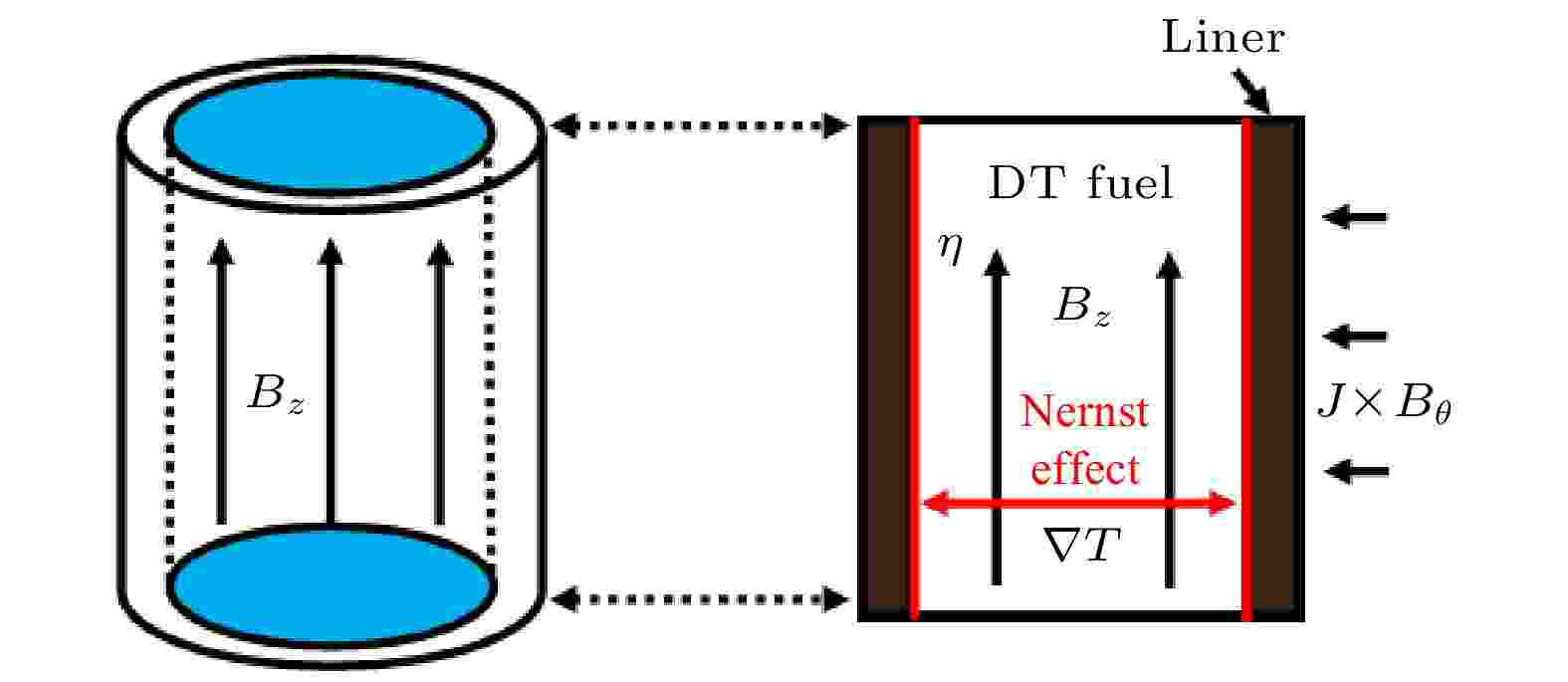
2021, 70 (13): 135201.
doi: 10.7498/aps.70.20202215
Abstract +
Axial magnetic field is one of the main parameters of magnetized liner inertial fusion (MagLIF), which is greatly different from other traditional inertial confinement fusion configurations. The introduce of axial magnetic field dramatically increases energy deposit efficiency of alpha particles, when initial Bz increases from 0 to 30 T, the ratio of deposited alpha energy rises from 7% to 53%. In the MagLIF process, the evolvement of magnetic flux in fuel can be roughly divided into three main stages: undisturbed, oscillation, and equilibrium. The distributions and evolution characteristic of axial magnetic field are both determined by the liner conductivity, fuel conductivity, and the fluid dynamics. The pressure imbalance between fuel and liner, caused by laser injection, is the source of fluid oscillation, which is an intrinsic disadvantage of laser preheating method. This fluid oscillation does not lead the magnetic flux to decrease monotonically in the fuel during implosion process, but oscillate repeatedly, even increase in a short time. Nernst effect plays a negative role in MagLIF process. As initial axial magnetic field decreases from 30 to 20 to 10 T, the Nernst effect causes magnetic flux loss to increase from 28% to 44% to 73% correspondingly, and the deposited alpha energy ratio drops from 44% to 27% to 4% respectively. So the initial magnetic field is supposed to be moderately high. The radial distribution of temperature in fuel should be as uniform as possible after preheating, which is helpful in reducing the influence of Nernst effect. Compared with Nernst effect, the end loss effect is much responsible for rapid drawdown of fusion yield. A large number of physical images are acquired and summarized through this work, which are helpful in understanding the process of magnetic flux compression and diffusion in MagLIF process. The simulation can act as a powerful tool and the simulation results can serve as a useful guidance for the future experimental designs.
CONDENSED MATTER: STRUCTURAL, MECHANICAL, AND THERMAL PROPERTIES
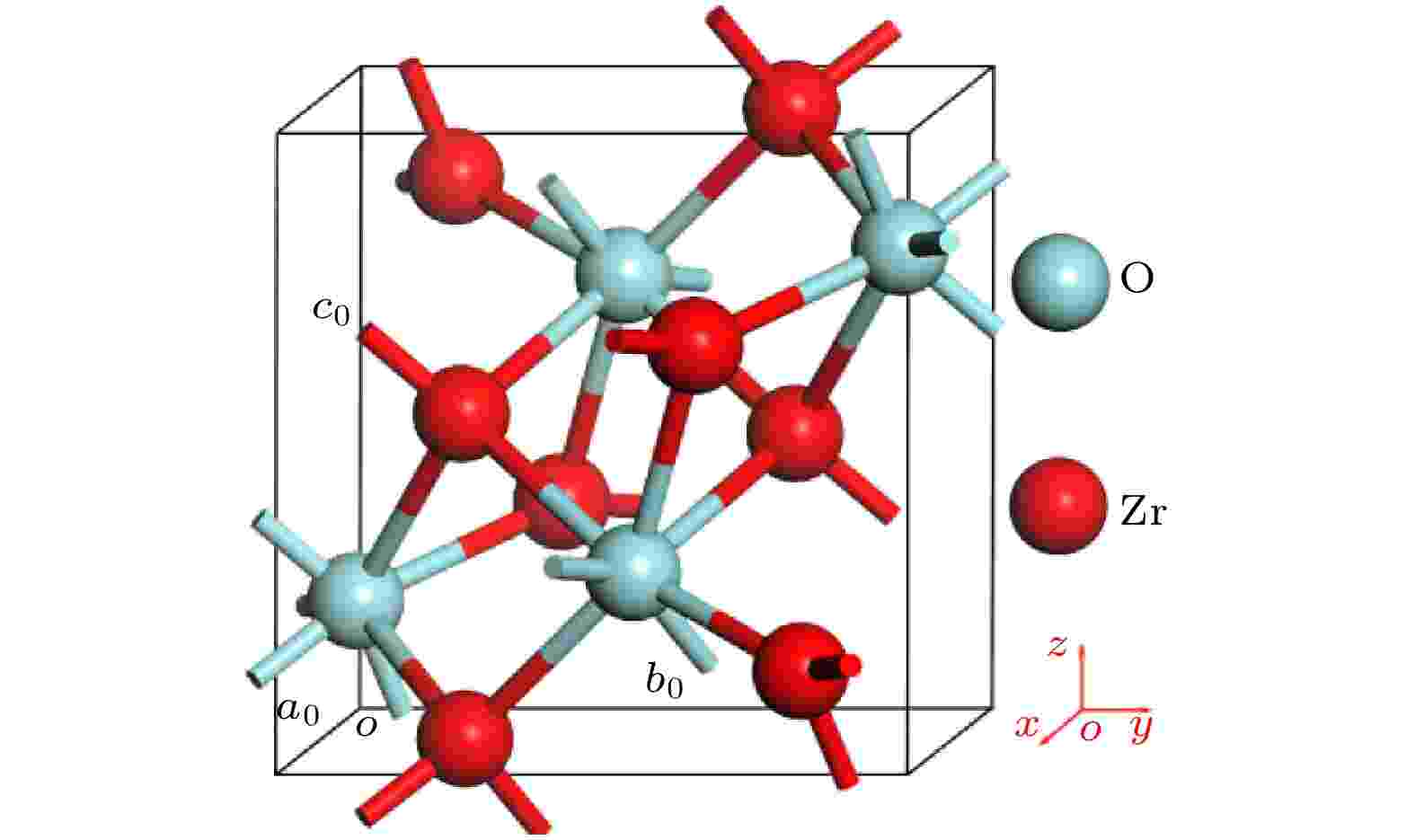
2021, 70 (13): 136101.
doi: 10.7498/aps.70.20201861
Abstract +
Owing to its excellent corrosion, radiation and high temperature resistance, ZrO2 has been considered as a strong candidate material for inert fuel for the incineration of actinides. In this paper, a combination of thermal spike model and molecular dynamics is used to simulate the phase transition process of ZrO2 in the nuclear radiation environment. Based on the thermal spike model, two coupled diffusion equations are established with considering the multiple physical process of energy deposition and transmission after the implantation of swift heavy ions into target material. The space-time evolution characteristics of ZrO2 lattice temperature are obtained by solving the coupled diffusion equations numerically. Then the phase transformation of ZrO2 form monoclinic phase to tetragonal phase under the thermal spike is investigated on an atomic scale by means of molecular dynamics. It is found that a cylindrical track with a radius of 7 nm is generated in the center of ZrO2 after the implantation of swift heavy ion with an electronic energy loss of 30 keV·nm–1. The lattice melts immediately in the center of track, accompanied with the coordination number of Zr decreasing from 7 to 4–6. Then at about 2 ps, the melting zone gradually turns cool and recrystallized. And in the center of the melting zone, voids begin to form and are surrounded by a highly disordered amorphous region. Meanwhile, tetragonal phase of ZrO2, whose coordination number of Zr is 8, is formed at the periphery of the amorphous region, which is also confirmed by the XRD calculation results. As energy transfers from track center to the surround, the tetragonal region gradually develops into the whole system, accompanied with the increase of voids size. The simulation results indicate that the irradiation of ZrO2 with swift heavy ions can lead to a transformation from the monoclinic to the tetragonal phase when the deposited electronic energy loss exceeds an effective threshold ~21 keV·nm–1, greater than the experimental value (12 keV·nm–1), which was mainly due to the large difference between the simulated and measured incident ion fluences and the accuracy of the force field used in the molecular dynamics.
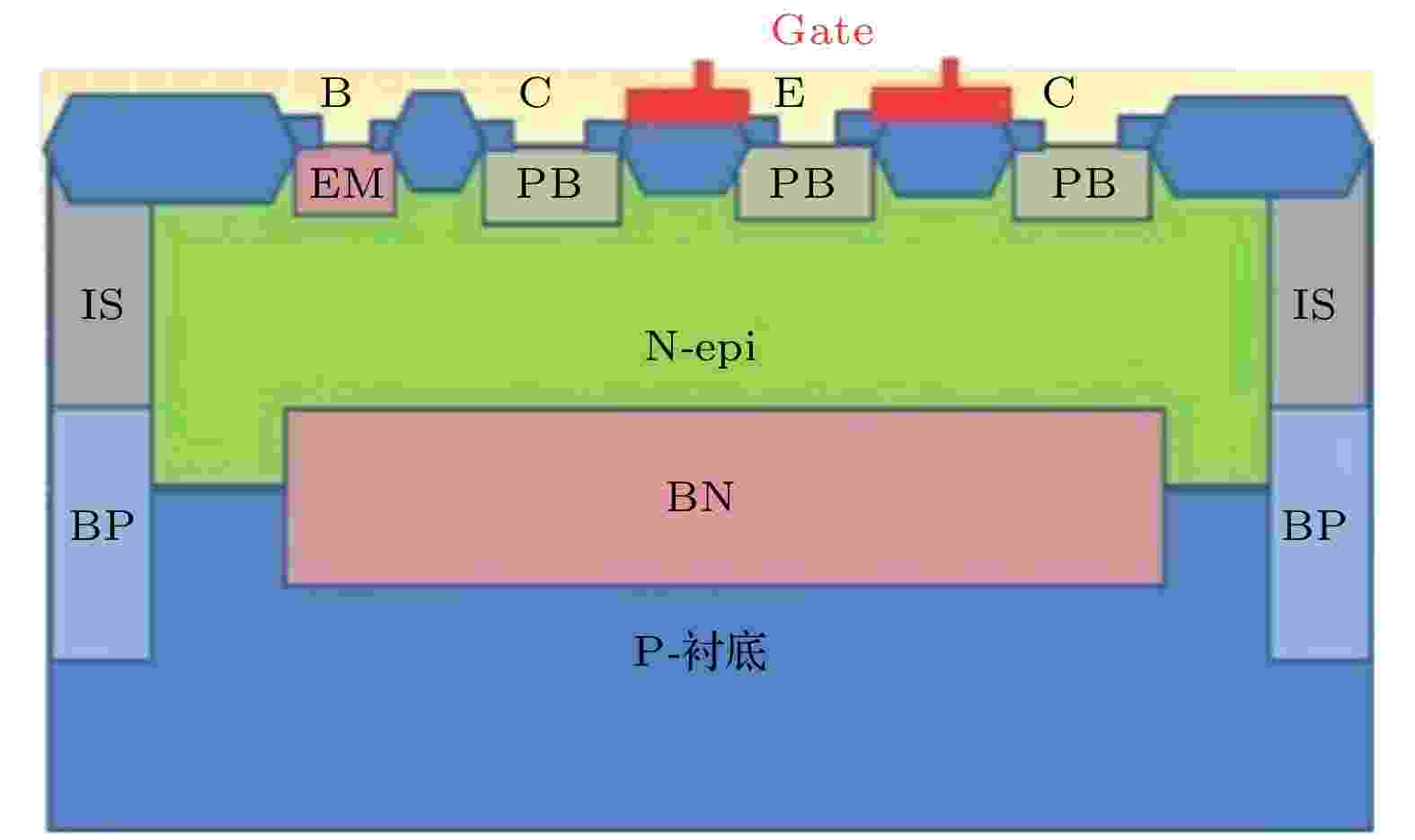
2021, 70 (13): 136102.
doi: 10.7498/aps.70.20201835
Abstract +
The base current (IB) of silicon bipolar transistor degrades when it is subjected to total ionizing dose (TID) irradiation, which is due to the generation of oxide trapped charges (Not) in the oxide layer and interface traps (Nit) at the silica/silicon interface. In this work, we investigate the statistical characteristic of IB of bipolar transistors and its possible microscopic origin. Especially, we carry out TID irradiation experiments on a large sample size of gated lateral PNP (GLPNP) transistors. Forty GLPNP transistors are sequentially irradiated to the total doses of 0.6 krad (Si), 2.6 krad (Si), 4.0 krad (Si), 7.4 krad (Si), and 10.8 krad (Si). The statistical characteristics of their IB

2021, 70 (13): 136201.
doi: 10.7498/aps.70.20210160
Abstract +
The single-layered molybdenum disulfide (${\rm{Mo}}{{\rm{S}}_2}$ ) is a two-dimensional nanomaterial with wide potential applications due to its excellent electrical and frictional properties. However, there have been few investigations of its mechanical properties up to now, and researchers have not paid attention to its nonlinear mechanical properties under the multi-fields co-existing environment. The present paper proposed a nonlinear plate theory to model the effect of finite temperatures on the single-layered ${\rm{Mo}}{{\rm{S}}_2}$ . It is similar to the classical plate theory that both the in-plane stretching deformation and the out-of-plane bending deformation are taken into account in the new theory. However, the new theory consists of two independent in-plane mechanical parameters and two independent out-of-plane mechanical parameters. Neither of the two out-of-plane mechanical parameters in the new theory, which describe the resistance of ${\rm{Mo}}{{\rm{S}}_2}$ to the bending and the twisting, depends on the structure’s thickness. This reasonably avoids the Yakobson paradox: uncertainty stemming from the thickness of the single-layered two-dimensional structures will lead to the uncertainty of the structure’s out-of-plane stiffness. The new nonlinear plate equations are then solved approximately through the Galerkin method for the thermoelastic mechanical problems of the graphene and ${\rm{Mo}}{{\rm{S}}_2}$ . The approximate analytic solutions clearly reveal the effects of temperature and structure stiffness on the deformations. Through comparing the results of two materials under combined temperature and load, it is found, for the immovable boundaries, that (1) the thermal stress, which is induced by the finite temperature, reduces the stiffness of ${\rm{Mo}}{{\rm{S}}_2}$ , but increases the stiffness of graphene; (2) the significant difference between two materials is that the graphene’s in-plane stiffness is greater than the ${\rm{Mo}}{{\rm{S}}_2}$ ’s, but the graphene’s out-of-plane stiffness is less than the ${\rm{Mo}}{{\rm{S}}_2}$ ’s. Because the ${\rm{Mo}}{{\rm{S}}_2}$ ’s bending stiffness is much greater than graphene’s, the graphene’s deformation is greater than MoS2’s with a small load. However, the graphene’s deformation is less than the ${\rm{Mo}}{{\rm{S}}_2}$ ’s with a large load since the graphene’s in-plane stretching stiffness is greater than the MoS2’s. The present research shows that the applied axial force and ambient temperature can conveniently control the mechanical properties of single-layered two-dimensional nanostructures. The new theory provides the basis for the intensive research of the thermoelastic mechanical problems of ${\rm{Mo}}{{\rm{S}}_2}$ , and one can easily apply the theory to other single-layered two-dimensional nanostructures.
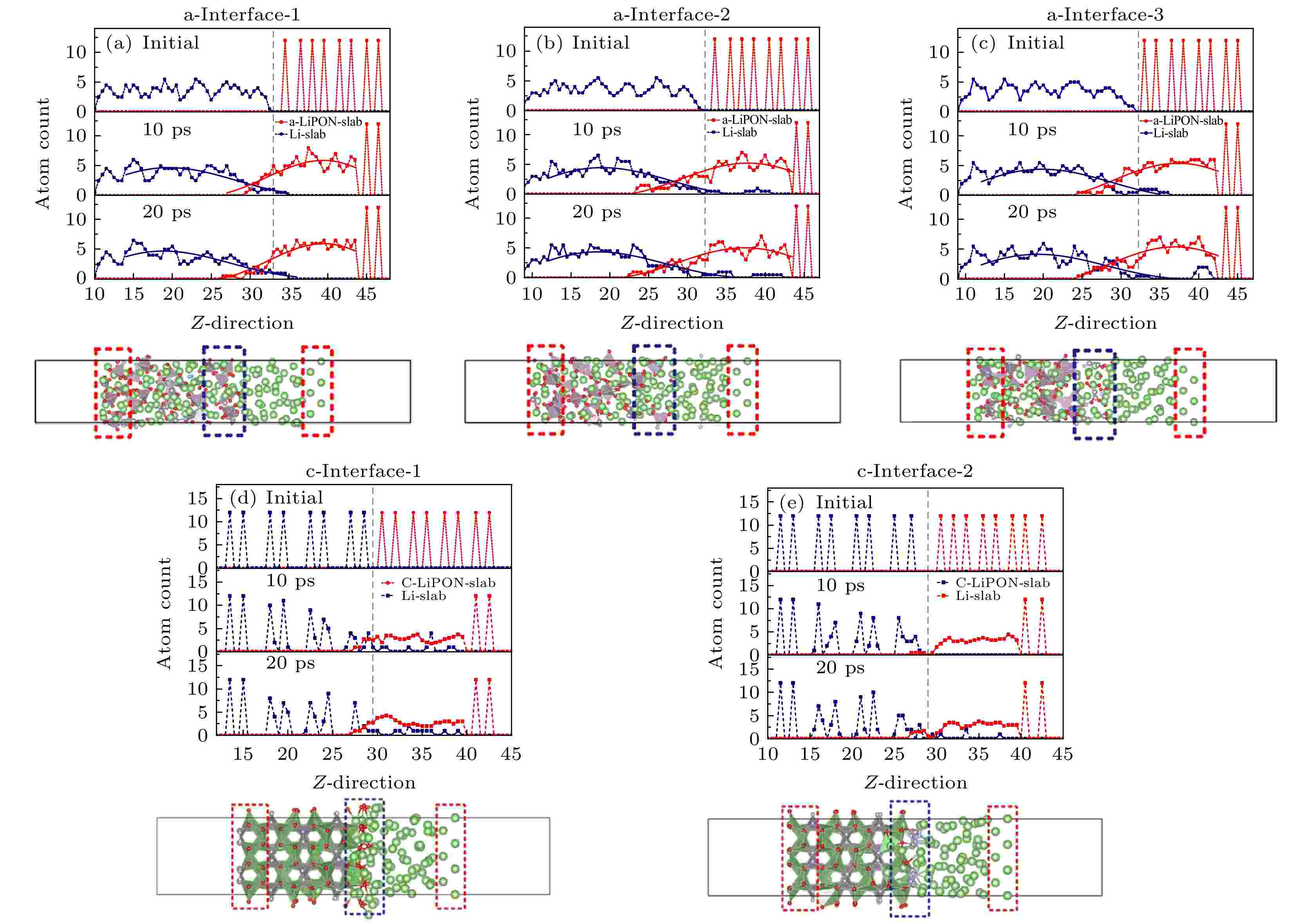
EDITOR'S SUGGESTION
2021, 70 (13): 136801.
doi: 10.7498/aps.70.20202214
Abstract +
In recent years, all-solid-state thin-film batteries have been used to power low-energy devices such as microchips, smart cards, microelectromechanical systems, wireless sensors, and implantable medical devices. All-solid-state thin-film batteries have become an important research direction of rechargeable solid-state batteries (SSBs). However, the solid-solid interface between electrodes and electrolytes seriously affects the further improvement of battery performance, which has attracted extensive attention. Lithium phosphorus oxynitride (LiPON) was found to be a useful inorganic electrolyte in lithium batteries because of its favorable electrochemical properties. For instance, LiPON has good electrical and chemical stability, negligible electronic conductivity and excellent cyclability as well as ease of integration with thin film battery with an electrochemical stability window. The LiPON can present two states, i.e. amorphous state and crystalline state. Here, we adopt ab initio molecular dynamics to study amorphous-LiPON/Li(100) interface and crystalline-Li2PO2N(100)/Li(100) interface. Our results demonstrate that the atomic inter-diffusion occurs in the interfacial region, forming a thin interfacial layer, and the ionic conductivity is increased after the interface layer has formed. Meanwhile, comparing with the Lipon bulk phase structure, the proportion of Li[O2N2], Li[O3N], and Li[O4] tetrahedral local structure in the interface layer with Li atom as the center decrease obviously, and the average coordination number of Li-O, Li-N, P-O, and P-N in the interfacial layers also decrease in the LiPON/Li interface. Due to the change of structure and coordination number at the interface, the ionic bonds between Li and O, N are weaker, which explains the increase of ionic conductivity at the LiPON/Li interface. Previous experiments showed that element interdiffusion occurs at the LiPON/Li interface and the interface layer is formed, and found that the decrease in impedance of the interface layer can confirm that the ionic conductivity of the interface layer indeed increases. In addition, the tetrahedral structure of the interface layer will be decomposed into other smaller structures. Our computational results are consistent with the previous experimental results, which indicates the rationality and reliability of our conclusion. This feature plays a positive role in promoting the performance of LiPON electrolytes in practical battery applications.
CONDENSED MATTER: ELECTRONIC STRUCTURE, ELECTRICAL, MAGNETIC, AND OPTICAL PROPERTIES
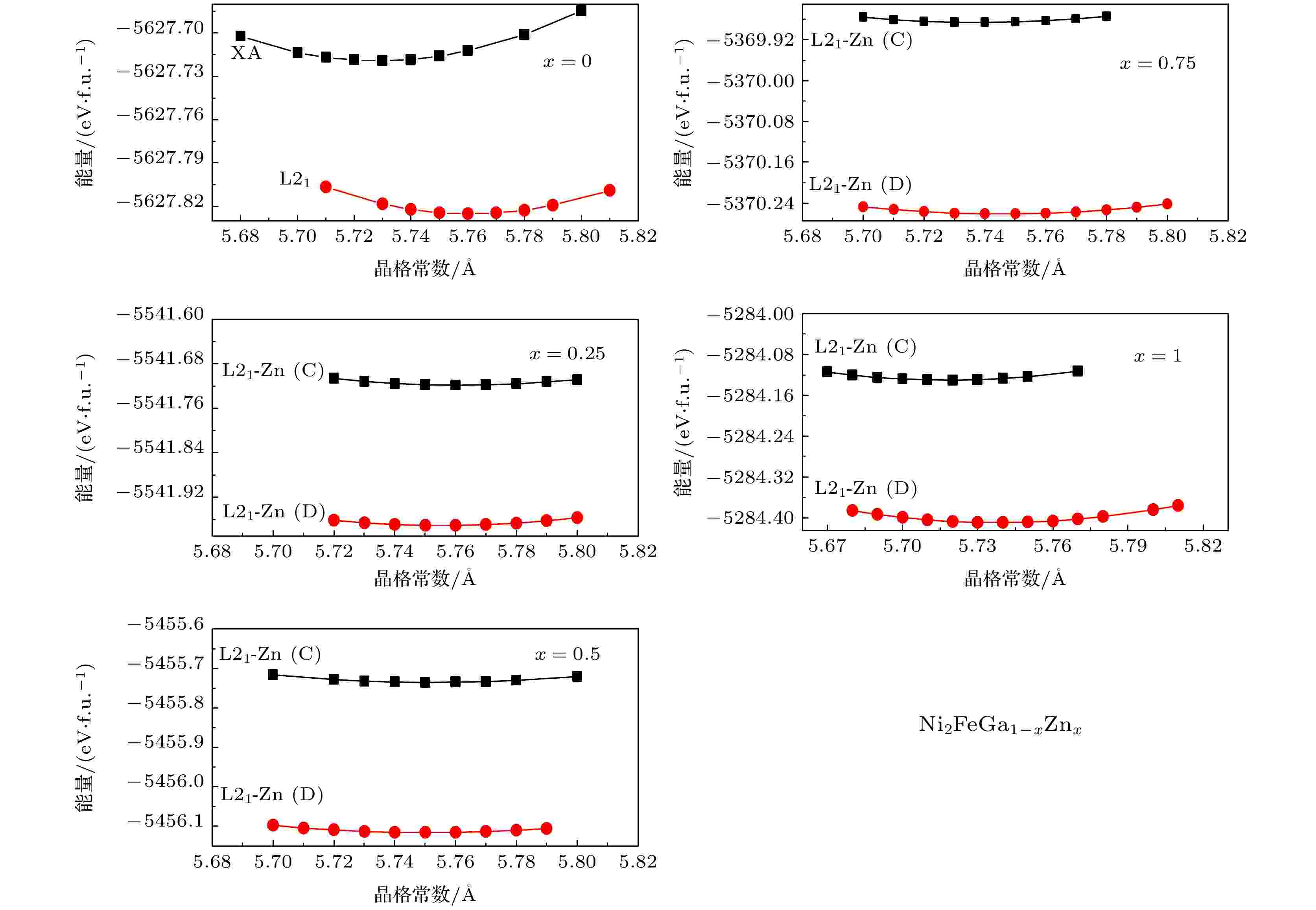
2021, 70 (13): 137101.
doi: 10.7498/aps.70.20202179
Abstract +
The magnetic shape memory alloys (MSMAs) have both martensitic transformation and ferromagnetism in the same material, thus external magnetic field can be used to induce/control the phase transformation or the reorientation of martensite variant. MSMAs have received considerable attention for their interesting properties and wide applications in different fields. For practical applications, the martensitic transformation temperature TM is an important factor and a high TM is preferable. Recently, Zn-doping has been found to be a possible way to elevate the value of TM of Ni-Mn based MSMA, but this effect on other kinds of MSMAs is not very clear yet. Heusler alloy Ni2FeGa is a typical MSMA with unique properties, however, its TM is relatively low. So it can be meaningful to find possible ways to increase its phase transition temperature. In this paper, the influences of Zn-doping on the electronic structure, martensitic transformation and magnetic properties of Heusler-type magnetic shape memory alloy Ni2FeGa are investigated by first-principle calculations. Total energy calculation and charge density difference indicate that Zn atom prefers to occupy the Ga (D) site when substituting for Ga in Ni2FeGa1–xZnx (x = 0, 0.25, 0.5, 0.75, 1). This main-group-element-like behavior is related to the closed 3d shell of Zn. Due to the similar atomic radii of Ga and Zn, Zn-doping does not lead the lattice constant to change greatly. The variation of the energy difference ΔEM between the martensite and austenite with Zn content increasing is calculated, and the result shows that ΔEM increases with Zn-doping increasing, and thus conducing to increasing the stability of the martensite phase and to evaluating the transformation temperature TM in Ni2FeGa1–xZnx. This trend can be explained by the Jahn-Teller effect observed in the DOS structure. The Zn-doping does not change the magnetic structure of Ni2FeGa. A ferromagnetic coupling between Fe spin moment and Ni spin moment can be observed within the whole range studied. The calculated total spin moment increases with Zn content increasing. The variation of formation energy Ef with Zn-doping is investigated. In Ni2FeGa1–xZnx a negative Ef is retained within the whole range studied, though it increases slightly with the doping of Zn. It is also found that the Zn-doping can increase the stability of L21 Heusler phase in Ni2FeGa1–xZnx and suppress the formation of the FCC L12 phase.
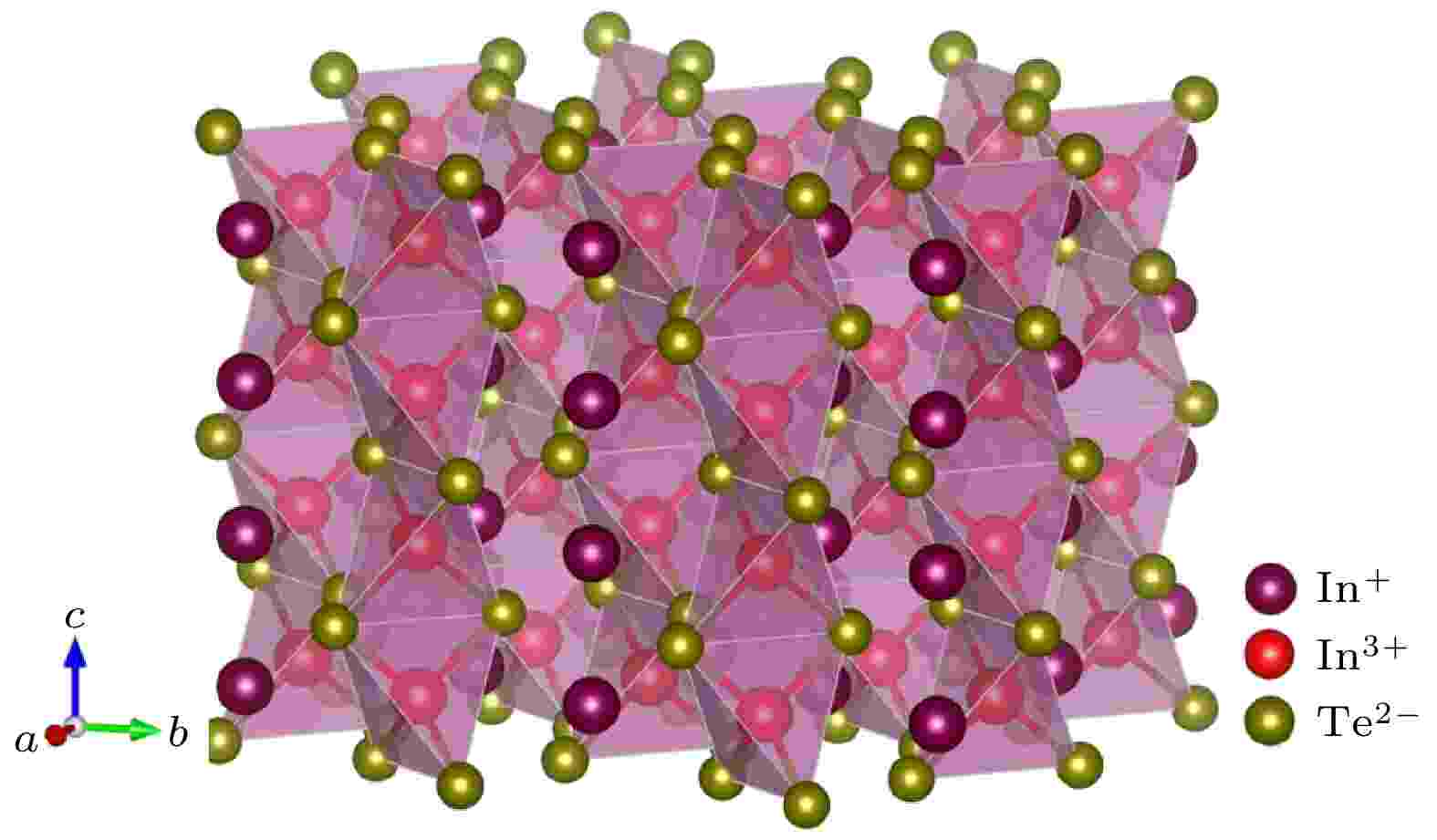
2021, 70 (13): 137102.
doi: 10.7498/aps.70.20210041
Abstract +
The inharmonic lattice vibration induced by the lone pair electrons of In+ in the InTe compound produces its intrinsically low thermal conductivity, thus InTe compound shows a great potential serving as an intermediate temperature thermoelectric material. However, its poor electrical transport properties result in an inferior thermoelectric performance. In this study, a series of single-phase In1+xTe (x = 0, 0.001, 0.003, 0.005, 0.01) polycrystalline samples were prepared by a melting-annealing process combined with spark plasma sintering. The influence of In content on the electronic and thermal transport properties for In1+xTe compounds was systematically studied. As the temperature rises, the predominant carrier scattering mechanism changes from grain boundary scattering to acoustic phonon scattering, leading to an unusual semiconductor-to-metal transition in In1+xTe samples. Positron annihilation spectroscopy and electrical transport properties demonstrate that In vacancies are the main source for the charge carrier. Adding extra In effectively suppresses the concentration of In vacancies, reduces the carrier concentration and improves the Seebeck coefficient of In1+xTe samples. The power factor of the In excess samples in the test temperature range is greatly improved in comparison with that of the pristine InTe sample. In1.005Te sample achieves a maximum power factor of 0.60 mW·m–1·K–2 at 585 K, which is approximately 40% higher than the pristine InTe sample. In addition, the In excess sample maintains a thermal conductivity as intrinsically low as the thermal conductivity of pristine InTe, and the total thermal conductivity of the In1.01Te sample at 773 K is 0.46 W·m–1·K–1. Owing to the improvement of the power factor and the low thermal conductivity, the ZT value of the In excess sample is greatly improved in the entire measure temperature range. A maximum ZT value of 0.71 is attained at 750 K for In1.003Te sample, and a maximum
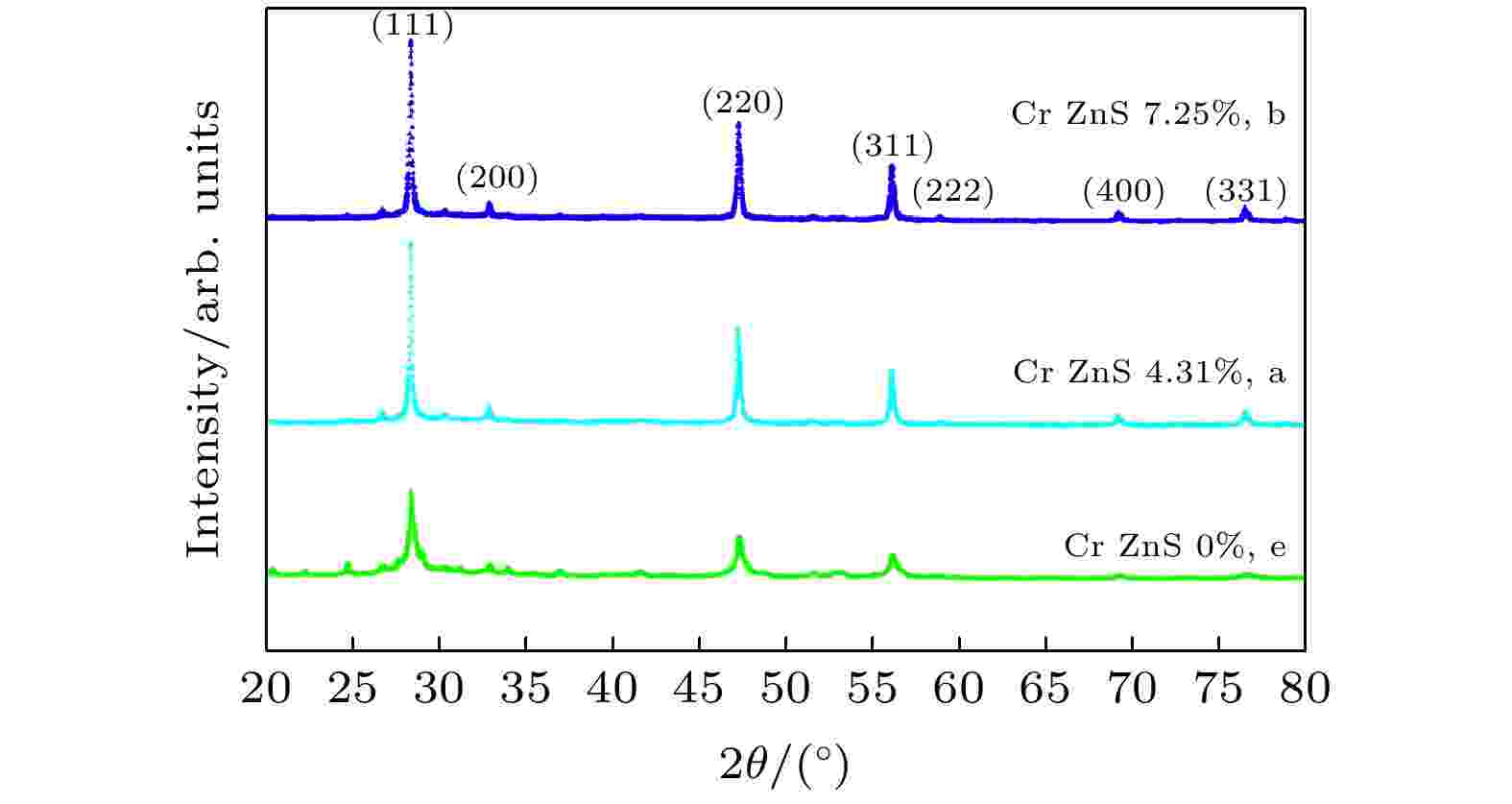
2021, 70 (13): 137103.
doi: 10.7498/aps.70.20201963
Abstract +
With the continuous development of nanotechnology, people have higher and higher requirements for the performances of nanomaterials. In the past few decades, researchers have used various methods to prepare nanomaterials with different dopants, and studied their optical and electrical properties. Nanomaterials with ferromagnetic properties have a wide range of applications, and there have been many reports about the ferromagnetic properties of doped magnetic elements. However, there have been few reports about Cr-doped ZnS and CdS. In order to obtain Cr-doped ZnS and CdS nanosheets with room temperature ferromagnetism, in this paper, using ethanolamine (EA) and ethylenediamine (EN) as mixed solvents, ZnS and CdS semiconductor nanostructures doped with different amounts of chromium are successfully prepared in S, ZnO and CdO sources by simple solvent thermal method. The X-ray diffraction (XRD) measurements show that the ZnS and CdS nanostructure have a wurtzite structure. Scanning electron microscopy (SEM) images show the morphologies of ZnS and CdS with different chromium content. When the content of Cr is 4.31 at% or 7.25 at%, the thickness of Cr-doped ZnS nanosheets is about 210–290 nm, and the morphology of undoped ZnS is composed of sub-morphologies of relatively thick nanosheets. The morphologies of CdS doped with different amounts of Cr are composed of sub-morphologies of snowflake like nanosheets with thickness of about 120–190 nm. Energy dispersive spectrometer (EDS) is used to observe the product composed of Cr, Zn, Cd, and S. The EDS measurement and calculation of the Cr content in Cr-doped ZnS nanosheets are 4.31 at% and 7.25 at% respectively, and those of the Cr content in Cr-doped CdS nanosheets are 1.84 at% and 2.12 at%. The vibration sample magnetometer(VSM) measurements show that ZnS doped with chromium exhibits ferromagnetism at room temperature, while the undoped ZnS exhibits diamagnetism at room temperature. The values of saturation magnetization Ms
INTERDISCIPLINARY PHYSICS AND RELATED AREAS OF SCIENCE AND TECHNOLOGY

2021, 70 (13): 138201.
doi: 10.7498/aps.70.20210064
Abstract +
Developing the cathode material with high voltage and high capacity is of critical importance in improving the energy density of the battery. Among various cathode materials, LiCoO2, as the first commercialized cathode material for lithium-ion batteries, is still widely concerned by many researchers due to its high output voltage, high volumetric energy density, and excellent cycling performance. However, a series of issues, such as serious capacity fading and performance deterioration, can emerge as cut-off voltage is above 4.5 V. Many strategies have been proposed to stabilize the cycling performance of LiCoO2 at high voltages. Mg doping is considered to be an effective strategy to improve the high voltage cycling stability of LiCoO2 cathode material, but the specific doping form and mechanism of Mg doping still need to be further studied. In this paper, the values of formation energy and the electronic structures of various configurations for Mg doping on Co and Li sites in LiCoO2 are investigated by the first-principles method based on density-functional theory. The calculated results show that the values of formation energy for different doping configurations are different and the substitution of Mg in LiCoO2 is complicated. When the doping concentration is 3.7%, Mg prefers to substitute for the Co site; while the doping concentration increases to 7.4%, Mg can replace not only the Co or Li sites, but also the Co and Li sites simultaneously. Therefore, it should not be simply believed that Mg ion can replace only Co or Li site in LiCoO2, depending on the specific doping situation actually. Furthermore, various doping configurations also exhibit different electronic states, including metallic state and semiconductor state, and what is more, electronic local states in many cases. Therefore, we believe that the Mg doping configuration in LiCoO2 is related closely to the doping amount, and the doping induced electronic structure also has a great difference.

2021, 70 (13): 138701.
doi: 10.7498/aps.70.20210015
Abstract +
The transcription factor p53 is the core of the cellular stress network, which controls cell fate decisions on genotoxic stress in a dynamics response manner. Mdm2 is an E3 ubiquitin ligase, which play a dual role in p53 regulation, that is, on the one hand, Mdm2 destroys the stability of p53 via ubiquitin labeling, and on the other hand, Mdm2 increase the efficiency of p53 production through binding p53 messenger RNA. A number of models indicate that Mdm2's inhibitory function on p53 plays a constructive role in the p53-Mdm2 vibrator, the research of how Mdm2's promotion function on p53 regulates the dynamics of this gene network, however, is still lacking. To this end, this paper uses a mathematical model to comprehensively explore the influence of the Mdm2 up-regulation p53 pathway on p53 dynamics. We adopt the ordinary differential equations (ODE) model and the bifurcation analysis method to investigate the multiple role of Mdm2 on p53 gene networks dynamics control. The results show that the phosphorylation of Mdm2 at Ser395, which forming a positive feedback loop (PFL) with p53, is essential for the oscillation of this gene network and may be the reason why there is a bimodal switch of p53 kinetics under etoposide stimulation; the previously reported phosphatase Wip1 is required for the oscillation of p53, which may only occur in situations where the intensity of the PFL mediated by phosphorylated Mdm2 is high, and we predict that Wip1 will inhibit the p53 oscillation in some weak PFL cases; Finally, our model also proves that Mdm2 promotes the deactivation and ubiquitination degradation of p53 is a key factor in the occurrence of repeated vibration dynamics of p53. The main conclusions of this paper are exhibited in some two-dimensional bifurcation diagrams. In order to confirm these bifurcation phenomena, we discuss the case where the Hill coefficient describing the degree of nonlinearity is small. As a result, there is no obvious shape change of the bifurcation curves surrounding the oscillation region. The robustness of these conclusions is verified again. We believe that our results can play a guiding role in the future related experiments of p53 kinetics.

EDITOR'S SUGGESTION
2021, 70 (13): 138801.
doi: 10.7498/aps.70.20201894
Abstract +
A reliable and efficient lithium-ion battery model is the basis of state estimation and fault diagnosis in the battery management system (BMS). The pseudo-two-dimensional (P2D) mechanism model represented by using partial differential equations has many parameters and high accuracy, but its calculation is time-consuming. The model order should be reduced for the on-board BMS. Here in this work, by using the same model parameters, the P2D model and the order-reduced models including the single particle model (SPM) and the lumped particle model (LPM) are built and their voltage accuracies and operation time are compared with each other. Based on the porous electrode model, the concentrated solution theory, and the assumption of uniform current of the battery, the current density is redistributed by the volume ratio of the solid phase to the liquid phase of the electrode. Furthermore, the overpotential and ohmic resistance caused by the lithium-ion concentration distribution in the liquid phase is deduced to offset the battery voltage bias under a large discharge rate. An unconstrained convex optimization method is established to optimize the concentration difference overpotential of the liquid phase of the P2D model battery, the optimized results of which are used to compensate for the LPM voltage.Under the conditions of the constant current discharge (CCD) of 0.1C — 4C at the ambient temperature, pulse discharge and dynamic stress test (DST), the electrical performance and the operation time of both the LPM and the SPM are compared to those of the P2D model. Some results are validated and given by the model simulation. Firstly, the accuracy of LPM is over 30% higher than those of the SPM at the CCD rates of 0.1 C, 0.5 C and 1 C, and about 30% worse than those of the SPM at the CCD rates of 2 C, 3 C, and 4 C. Secondly, the optimized LPM can produce a voltage in good approximation to the voltage of the P2D model with an absolute relative error of the model voltage below 1.5% whether it is caused by the CCD or the DST. Thirdly, the optimized LPM can run efficiently and the needed calculation time cuts down by 85% and 65% for the P2D and the SPM, respectively. For the real-time applications of lithium-ion batteries, the proposed compensation method by adding the overpotential in the liquid phase can make the LPM produce reliable voltage with shorter operation time than either the SPM or the P2D model.
GEOPHYSICS, ASTRONOMY, AND ASTROPHYSICS
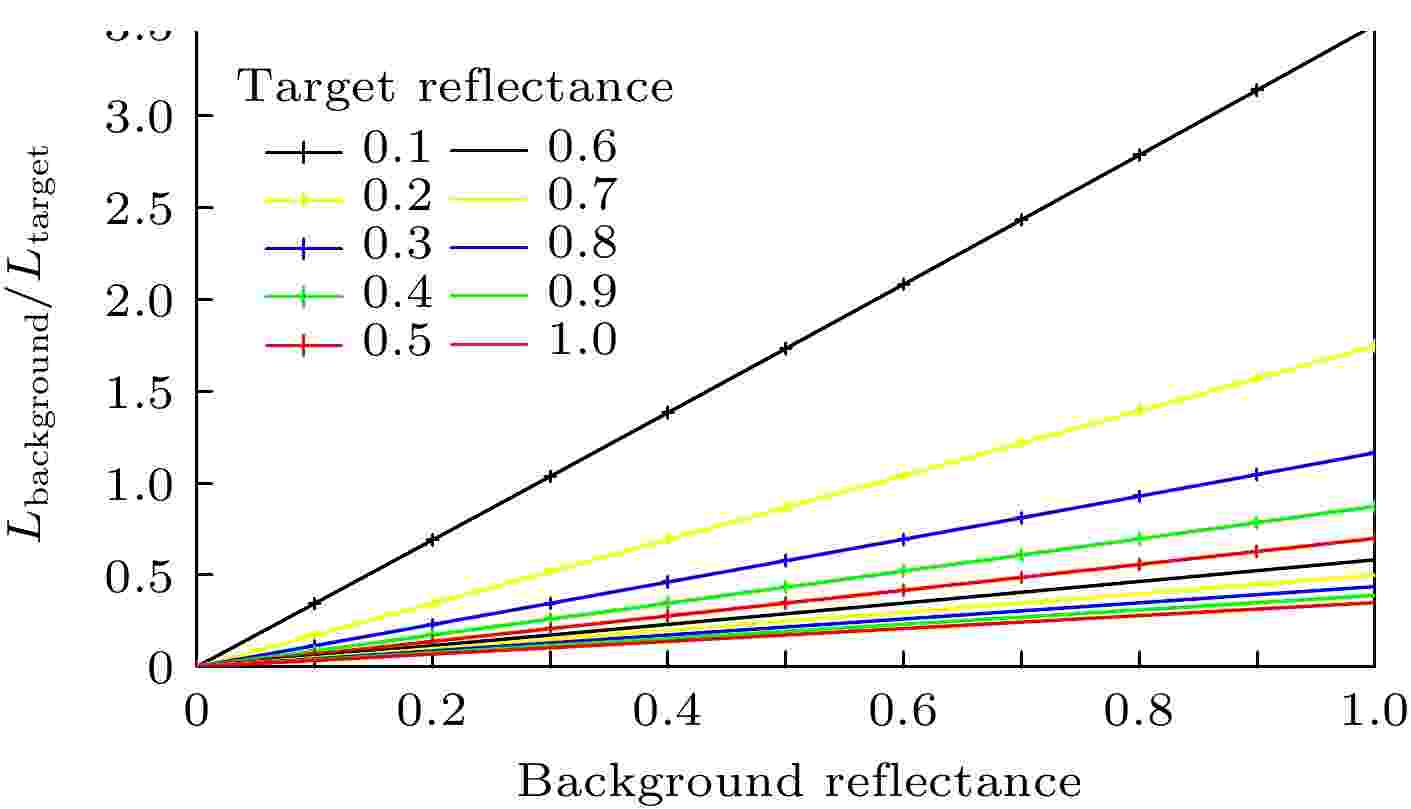
2021, 70 (13): 139101.
doi: 10.7498/aps.70.20202187
Abstract +
The adjacency effect, the contribution of the neighboring pixels to the radiance of the line of sight pixel, is caused by the Rayleigh scattering of atmospheric molecules and Mie scattering of aerosol particles. The adjacency effect will cause the reflectance of each pixel in the apparent reflectance satellite image to be between the real reflectance and the average background reflectance, reducing the accuracy of the surface reflectance inversion. Therefore, it is very important to remove the adjacency effect to improve the accuracy of retrieving the surface reflectance from satellite images. The most critical issue of the adjacency effect is to accurately calculate the weight of the contribution of each background pixel to the adjacency effect. The weight value of the contribution of each background pixel to the adjacency effect mainly depends on the spatial distance between the target pixel and the background pixel, the difference in reflectance between the target pixel and the background pixel, and the optical thickness of atmospheric molecules and the optical thickness of aerosol. At present, the commonly used weight function for calculating the weight value considers only the influence of optical thickness and spatial distance on the weight value. These weight functions are applied to a relatively uniform surface. However, when these weight functions are applied to an inhomogeneous surface, they will greatly reduce the accuracy of the adjacency effect correction. The combination of ground features in satellite images with the sub-meter spatial resolution is complex, so the influence of the difference in reflectance between the target pixel and the background pixel on the adjacency effect must be considered. The adaptive atmospheric correction algorithm proposed in this paper can adjust the weight value of the contribution of background pixels to the adjacency effect according to the spatial distance between the target pixel and the background pixel, the difference in reflectance between the target pixel and the background pixel, and the difference between the atmospheric molecules’ optical thickness and aerosol optical thickness. The adaptive atmospheric correction algorithm is used to correct the adjacency effect on GF-2 panchromatic satellite images. The results show that the adaptive atmospheric correction algorithm can effectively remove the adjacency effect in sub-meter spatial resolution optical satellite images, improve both the accuracy of quantitative study and the satellite image quality.

2021, 70 (13): 139201.
doi: 10.7498/aps.70.20202183
Abstract +
In the summer of 2019, one case of electric field sounding in eyewall of No.1907 typhoon named Wipha was obtained in Wenchang, Hainan Island, China. Up to now, it has been the first case of electric field sounding results obtained in a typhoon system. In this paper, based on the observations of satellite, meteorological radar, ground electric field and cloud-to-ground flash location data of Hainan province, China, the basic characteristics of the typhoon are analyzed in detail. Owing to the limitation of cloud-to-ground flash location system, only flash activities of the typhoon before and after landing period are analyzed and the result does not show obvious features as reported by other researches. Referring to the radar reflectivity and sounding path, we confirm that the sounding penetrates through the eyewall region of the typhoon from cloud base to top. The electric field profile and the charge region distribution in the sounding path area are analyzed, and the results show that four positive and three negative charge regions exist between 5.74 and 9.10 km above sea level and the corresponding temperatures range from –2.4 to –16.7 ℃ of the seven charge regions. The mean charge densities of each charge region from bottom to top are 0.63 nC/m3, –0.33 nC/m3, 0.31 nC/m3, –1.03 nC/m3, 1.70 nC/m3, 1.57 nC/m3 and –1.20 nC/m3, respectively. According to the preliminary analysis, we consider that the two positive charge layers at the top should be in the same charge region. Under the comprehensive consideration of the thickness of charge regions, the intensities of these six charge regions are 0.33 nC/m2, –0.07 nC/m2, 0.06 nC/m2, –0.87 nC/m2, 0.73 nC/m2, and –0.18 nC/m2, respectively. We can find that there are three dominant charge regions with largest intensity and they are the lowest positive charge region, the middle main negative region, and upper main positive charge region. And these vertical distributions of the three dominant charge regions are characterized by a tripole charge structure. These results are basically consistent with some simulation results. In addition, a negative screen charge region with a shallow depth in a range of 15–20 dBZ of the upper cloud boundary can be found. Combining the popular charging mechanisms, the similarity of tripole charge structure between our sounding and normal thunderstorm are discussed, and we preliminary consider that the non-inductive charging mechanism and the inductive charging mechanism, which originate from normal convection, are also suitable for eyewall region of typhoon.
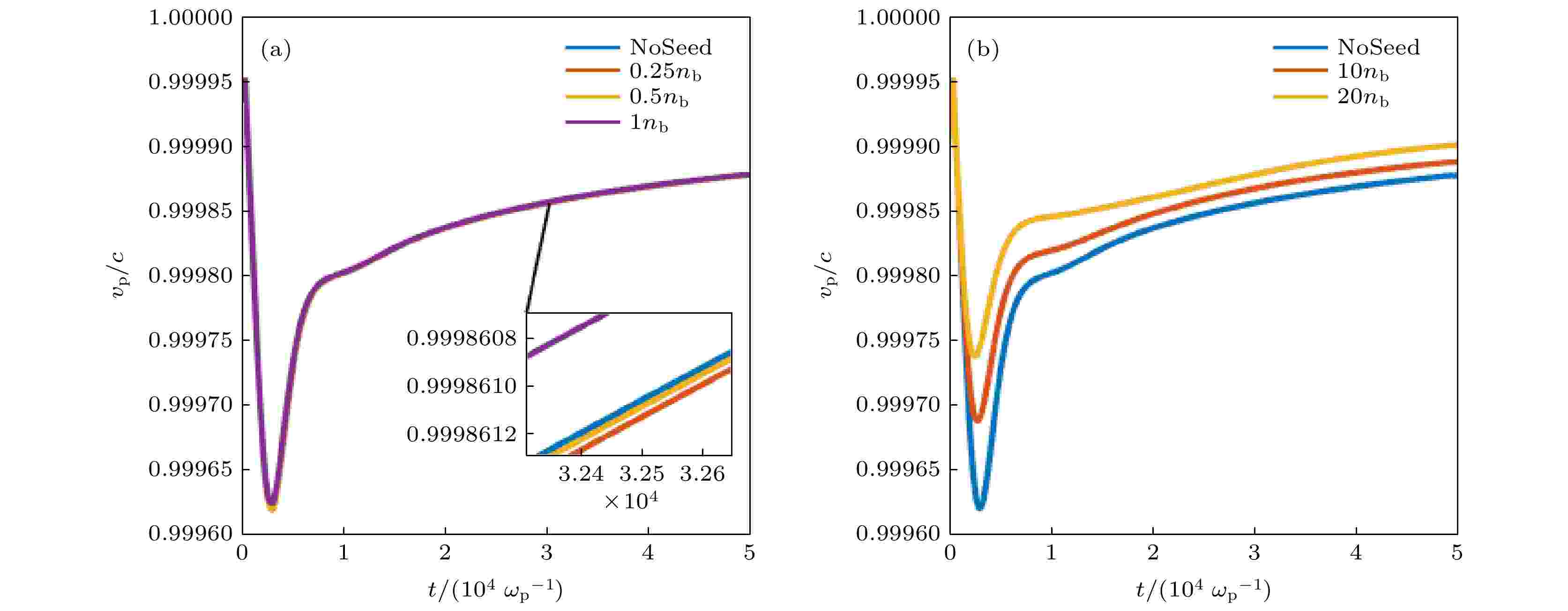
EDITOR'S SUGGESTION
2021, 70 (13): 139401.
doi: 10.7498/aps.70.20202086
Abstract +
Significant progress has been made in the studies of wakefield excitation in plasma by a self-modulated high energy proton beam in the past decade. The electron beams accelerated up to 2 GeV by using such a wakefield were demonstrated in the AWAKE experiment at CERN in 2018. Aiming at the application of high energy particle accelerators, new ideas have been investigated in recent years, such as seeding the proton beam self-modulation with an electron beam in order to enhance the strength and stability of the wakefield or adding a density transition in the plasma distribution to enhance the phase velocity and the strength of the wakefield. Here in this work, we investigate the effects of electron beam seeding on the phase velocity of the wakefield generated by the modulated proton beam in plasma. The physical mechanisms responsible for the phase velocity change and the roles played by the electron beam seeding are discussed. The theoretical analysis and two-dimensional particle-in-cell simulations show that both the growth rate and the phase velocity of the wakefield generated by the modulated proton beam can be enhanced by the electron beam seeding. The higher the charge density of the electron beam, the more significant the enhancement effects. The effects of electron beam energy and proton beam longitudinal profiles on the increase of phase velocity are also studied. It is shown that the evolution of the electron beam distribution has a significant effect on the seeding self-modulation process, and thus affecting the phase velocity. A self-focusing electron seeding beam can increase the phase velocity of the wakefield even to superluminal while an expanding seeding beam can reduce the phase velocity and destroy the stability of the whole process. This work may benefit the proton beam seeding self-modulation acceleration and its applications.
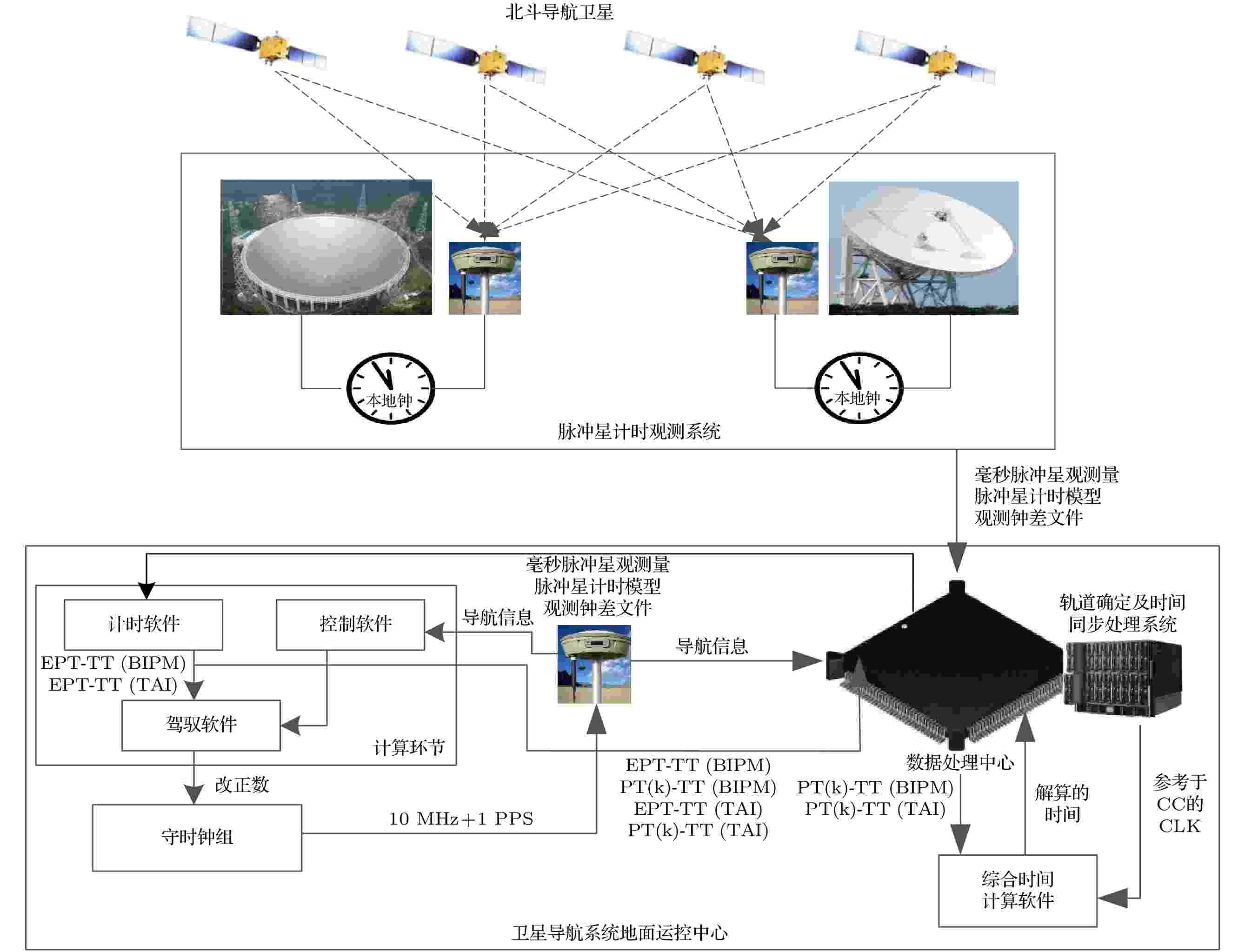
COVER ARTICLE
2021, 70 (13): 139701.
doi: 10.7498/aps.70.20210288
Abstract +
The comprehensive positioning navigation timing (PNT) system in China is a multi-source information fusion system with BeiDou navigation satellite system (BDS) as a core. The high-precision millisecond pulsar timing can enhance the long-term stability of the BDS time benchmark and maintain a space-time benchmark for future deep-space users. In this paper, a ground-based pulsar time service system is proposed for detecting and improving the time benchmark of BDS. The preliminary designs and functions of the system are outlined. At the same time, the method of establishing space and ground-based pulsar time is studied. The ground radio timing data from the international pulsar timing array (IPTA), the X-ray timing data from the neutron star interior composition explorer (NICER) in space, and the simulation data from the 500-meter spherical radio telescope (five-hundred-meter aperture spherical radio telescope, FAST) for three millisecond pulsars are used to analyze the stability of ground/space-based pulsar time. The research results are as follows. The annual stability of the PSR J0437-4715 ground-based pulsar time based on IPTA data is 3.30 × 10–14, and the 10-year stability is 1.23 × 10–15, respectively. The existence of pulsar red noise can reduce the time stability of the pulsar. The annual stability of the PSR J1939+2134 ground-based pulsar time is 6.51 × 10–12. We find that the accuracy of the pulse time of Arrival(TOA) is an important factor that restricts the stability of space-based pulsar time. Based on NICER space X-ray timing data, the stability of the pulsar time for PSR J1824-2452A is 1.36 × 10–13 in one year. Finally, the simulation analysis of the FAST’s data without considering the influence of red noise is completed, and we find that the PSR J1939+2134 ground-based pulsar time based on the FAST has an annual stability of 2.55 × 10–15, a 10-year stability of 1.39 × 10–16, and a 20-year stability of 5.08 × 10–17. It demonstrates that the powerful pulsar observation capability of FAST will help to improve the accuracy of ground-based pulsar time and enhance the long-term stability of the comprehensive PNT system time benchmark in China.




































